-
Posts
648 -
Joined
-
Last visited
Content Type
Profiles
Forums
Gallery
Events
Posts posted by rvchima
-
-
-
Third Deck Planking
The technique of gluing planks to a paper backing is working extremely well. The 2 mm walnut strips supplied with the kit are about 20" long, and I am gluing up 10" segments of 2, 3, 4, and 5 strips, plus segments of 1+2+2+1 mm strips that fit the doors and windows. I put a stop block on my cutting board to cut pieces to the height of the cabin. I saw with paper side down so the wood doesn't tear when the saw cuts through.
Another big advantage is that when I mess up and glue something crooked, it cuts off easily through the paper backing and just requires a little sanding to remove the paper.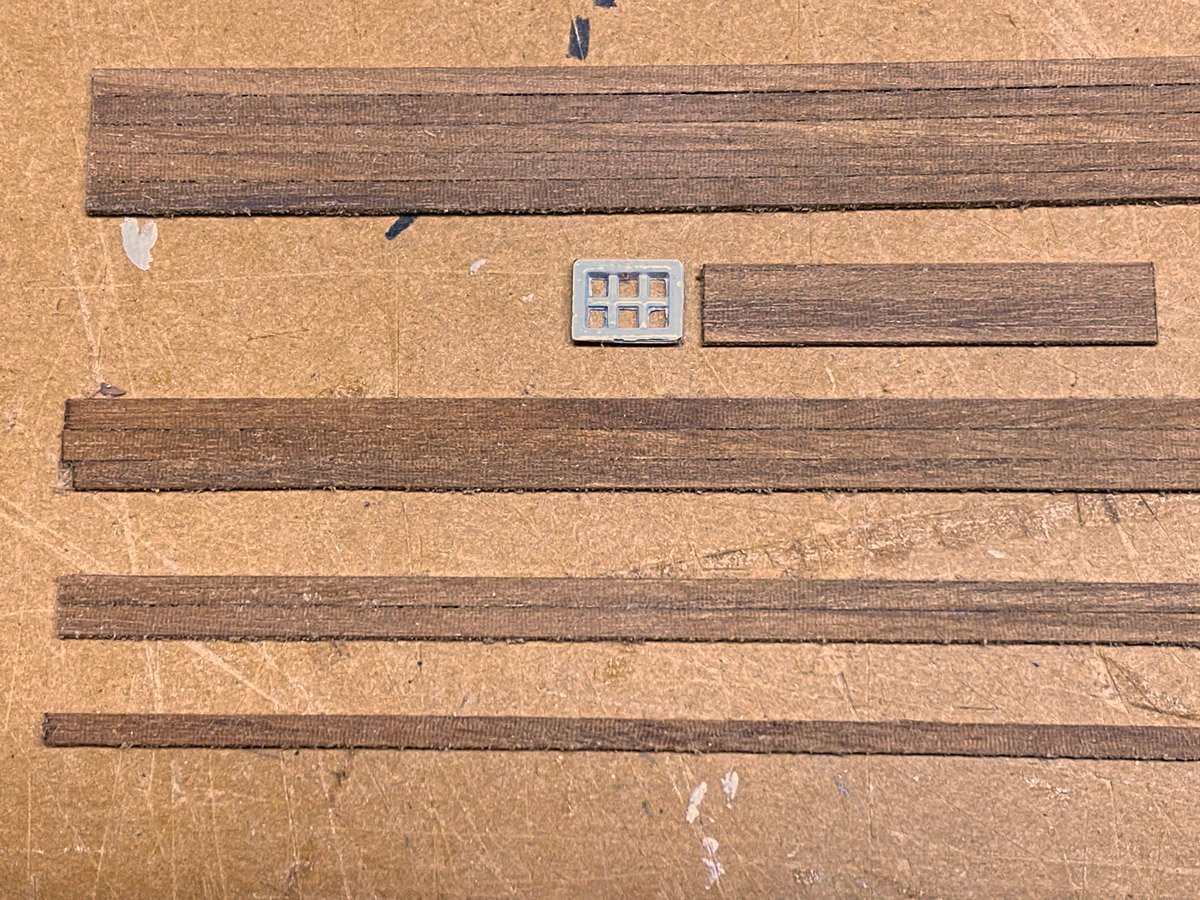
I planked the forward cabin, sanded and oiled it in two days. Then painted the window interiors and added the windows and doors in a couple more hours.
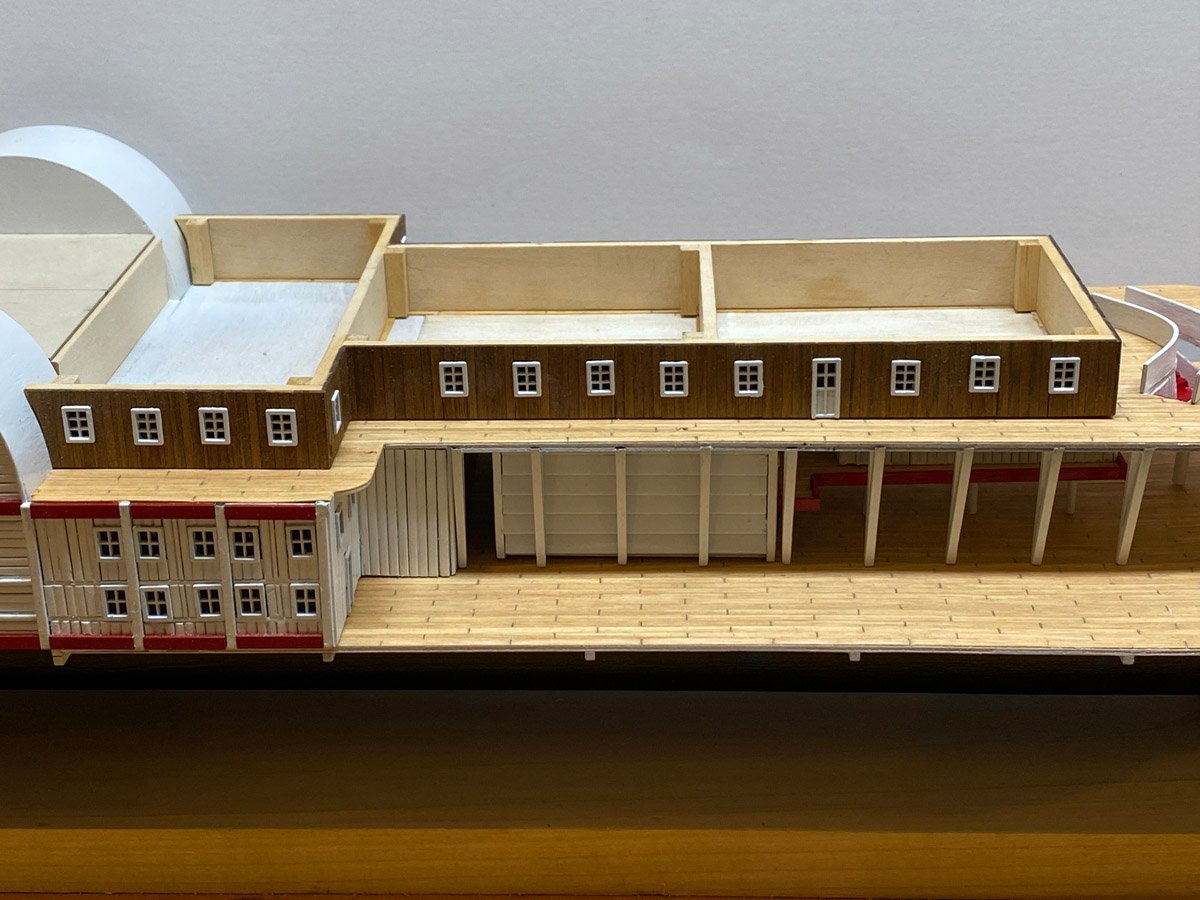
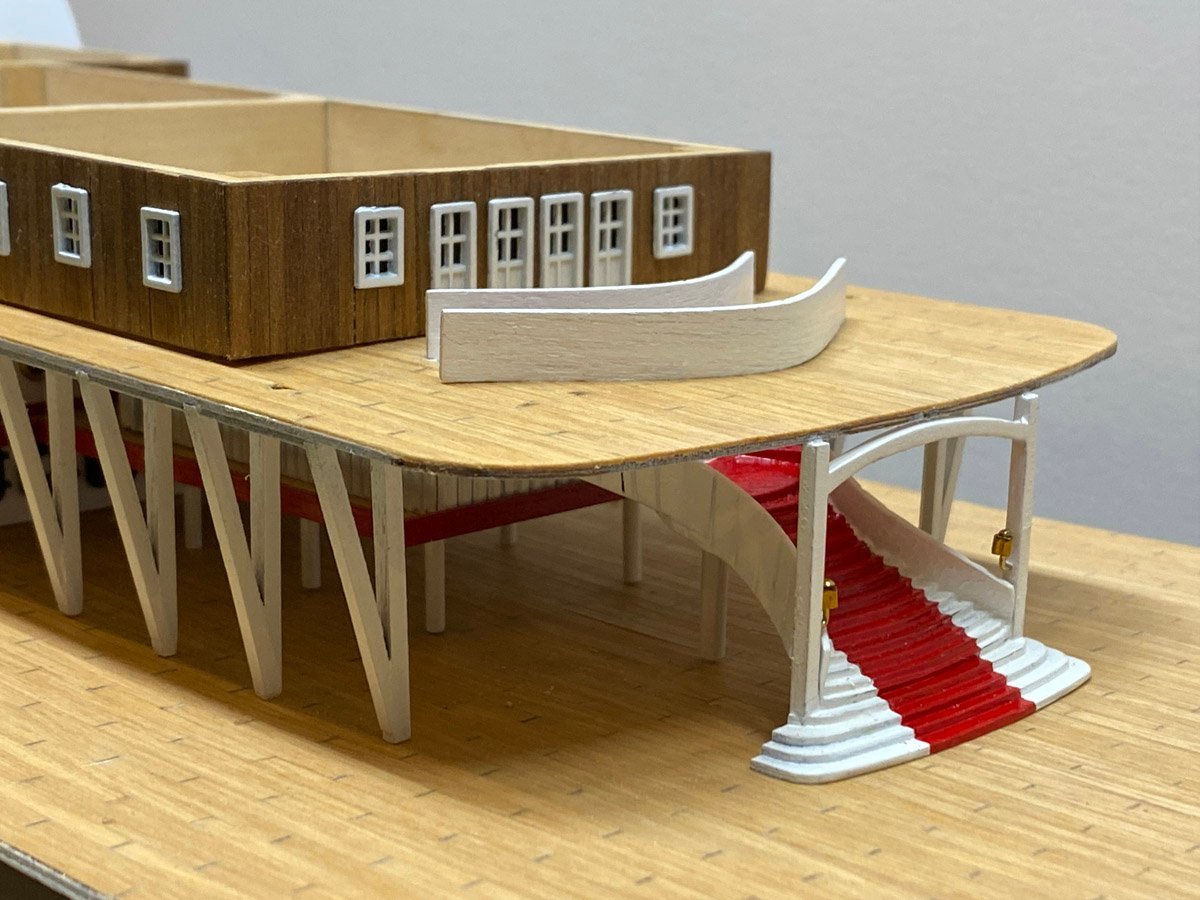
The flat planks on the walnut cabins look SO much better than the chamfered planks on the painted cabins. The next deck is back to white, and I will totally forget the chamfering.
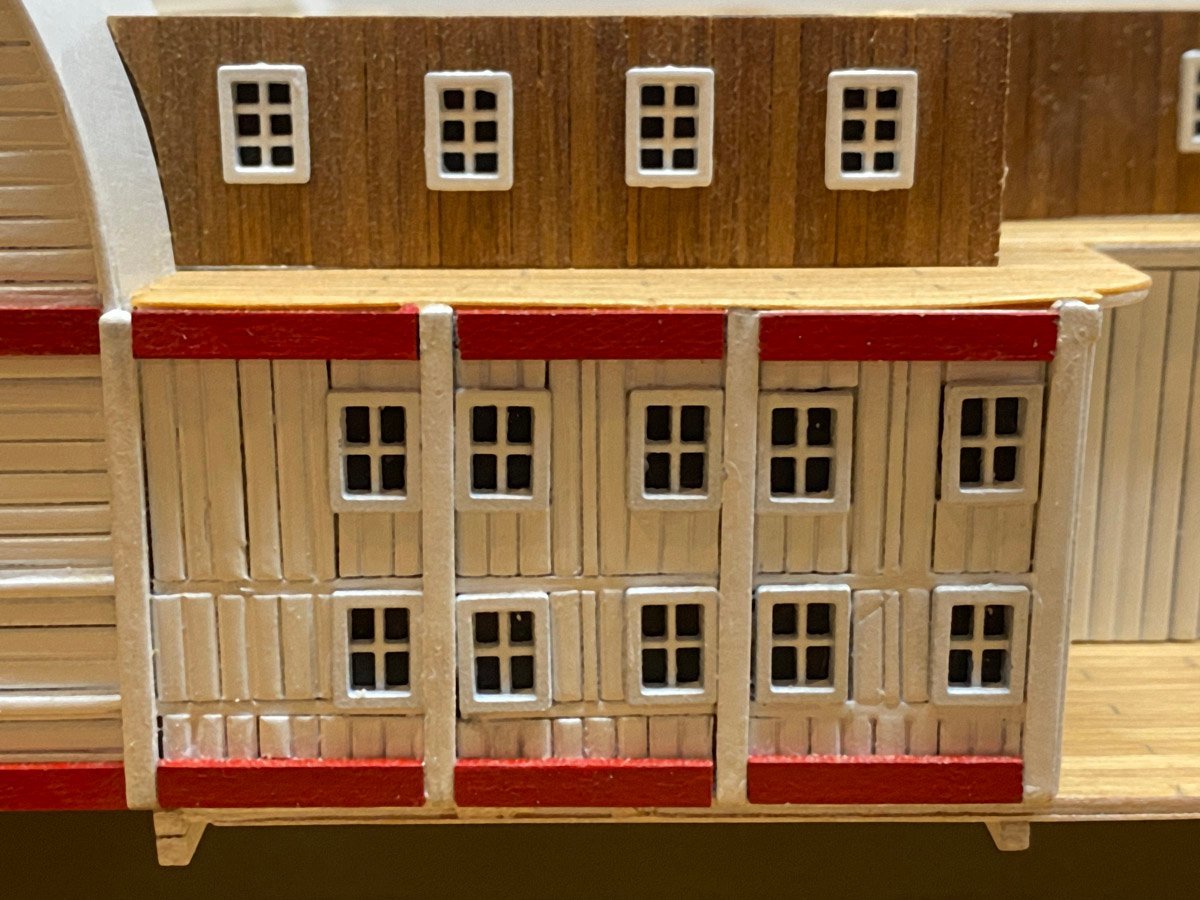
I planked the aft cabin in 3 hours.
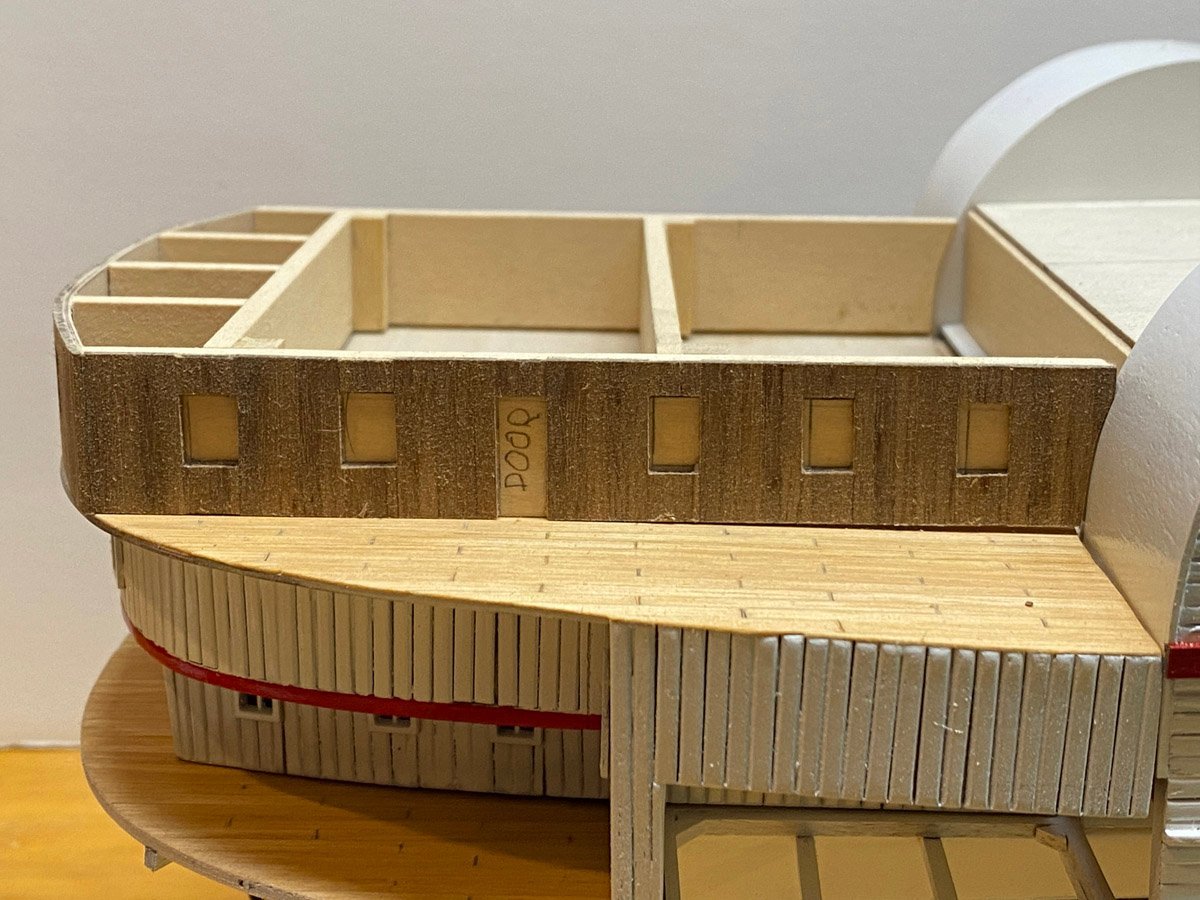
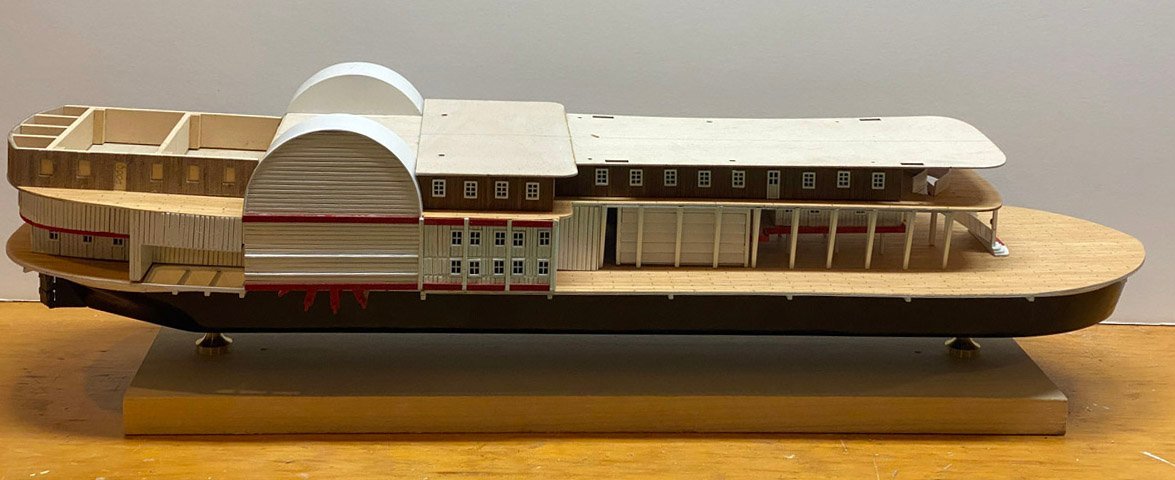
- yvesvidal, Haliburton, Nunnehi (Don) and 7 others
-
 9
9
-
 1
1
-
Grand Staircase
The staircase is cast metal. It needed a little sanding to flatten the top, but wasn't too bad otherwise. There is a support dowel between the deck and staircase landing, so I drilled through the center of the landing to make a tight fit for the dowel. The four bottom stairs are individual pieces of plywood that are glued up and angled to fit the slope of the fore deck. I used double sided tape to hold everything in place, used a little CA to glue the bottom stairs and dowel permanently, then removed the assembly for painting.
The columns and arch were built separately and glued to the staircase. The instructions called for lamps on the two columns. No lamps were included with the kit, so I made some with tiny gold beads on brass pins.
I really liked rodgerdodger's red carpet treatment, so I borrowed the idea. This is the first thing that passengers would see when boarding the ship, inviting them to go upstairs. Good thing, because the next thing they would see is the boiler room.
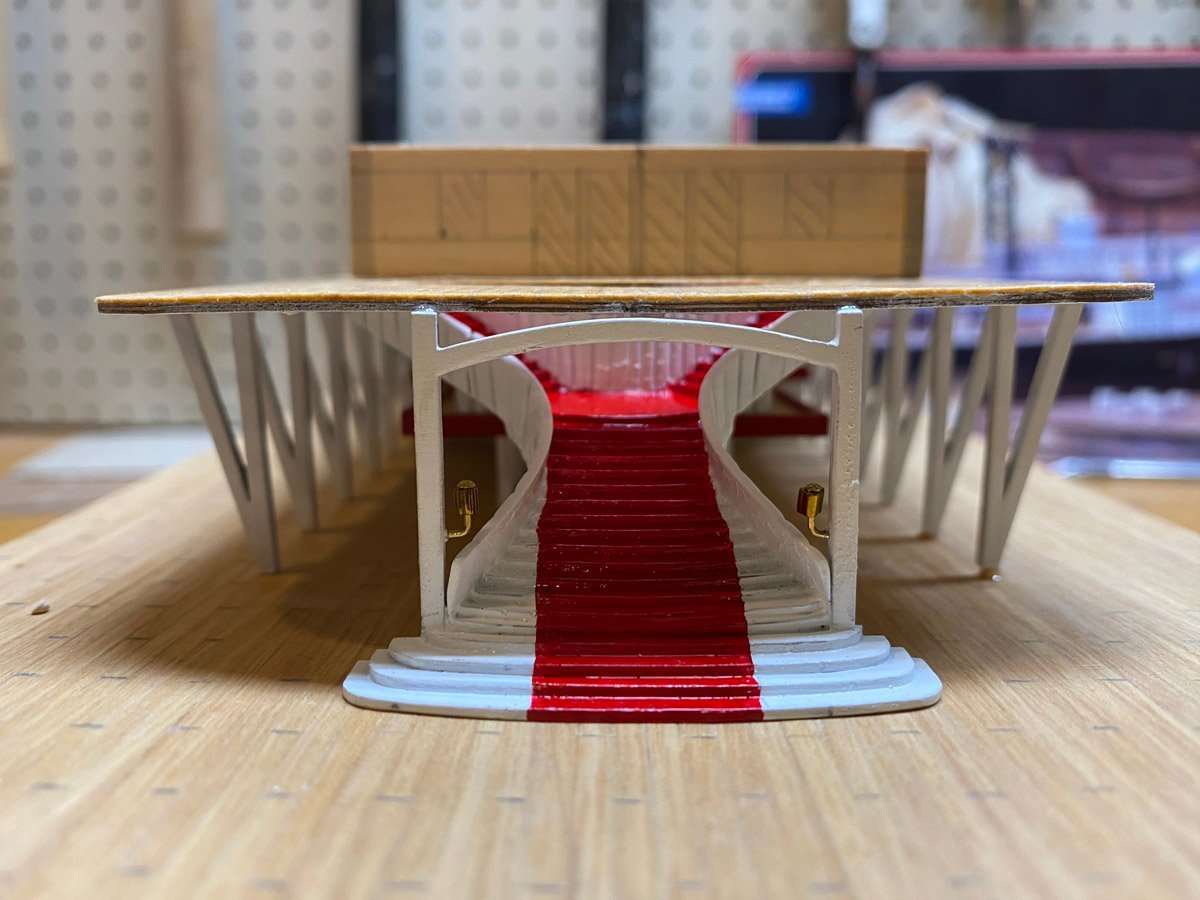
- Swinging the lead, hof00, schooner and 3 others
-
 6
6
-
Tim,
I just discovered your build a few days ago and have been meaning to comment. As you mentioned, this is not an easy hull to build. There are not enough frames, and all those frame extensions and rudder support just want to break off. You've already tackled that. I think the model should be double planked for strength.
You are doing a beautiful job, and I'll be following along to see her in the water.
-
First Level Painted, Windows, Doors, and Paddle Wheels Installed - 112 hours over 36 days
I painted the cabins with 2 coats of Tamiya white primer and 2 coats of Krylon gloss white, all from rattle cans. Red trim was painted in full strips with Testor's red spray, cut to length, and touched up after installation. Window backgrounds were hand-painted with black acrylic, and windows installed with a touch of medium CA.
Paddle wheels installed and cabin placed back on the hull. The instructions recommended chamfering the edges of the hull planks. That leaves obvious gaps between the planks, and spray paint just doesn't get in there. The next couple of decks are natural walnut, and I think I'll leave the planks flat.
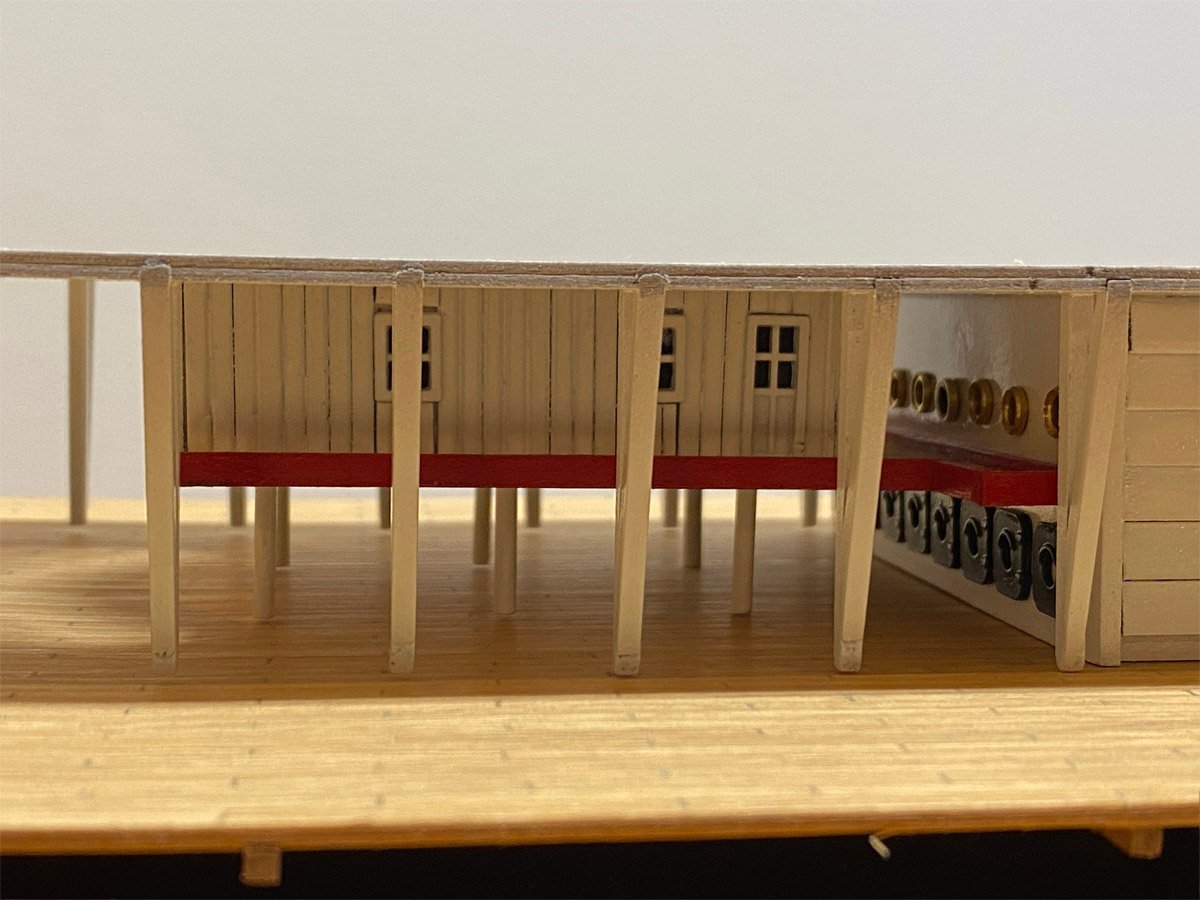
Colonnade and raised cabin installed in front of boiler room. The boiler room has 8 turned brass view windows (portholes) over 8 firebox doors. One of the portholes went flying in my shop, never to be seen again. After hours of searching I made a replacement out of nested pieces of brass tubing. It looked almost perfect, and you can't see it back there anyway. I suppose firewood (or coal?) was stored under the raised cabin right in front of the firebox doors.
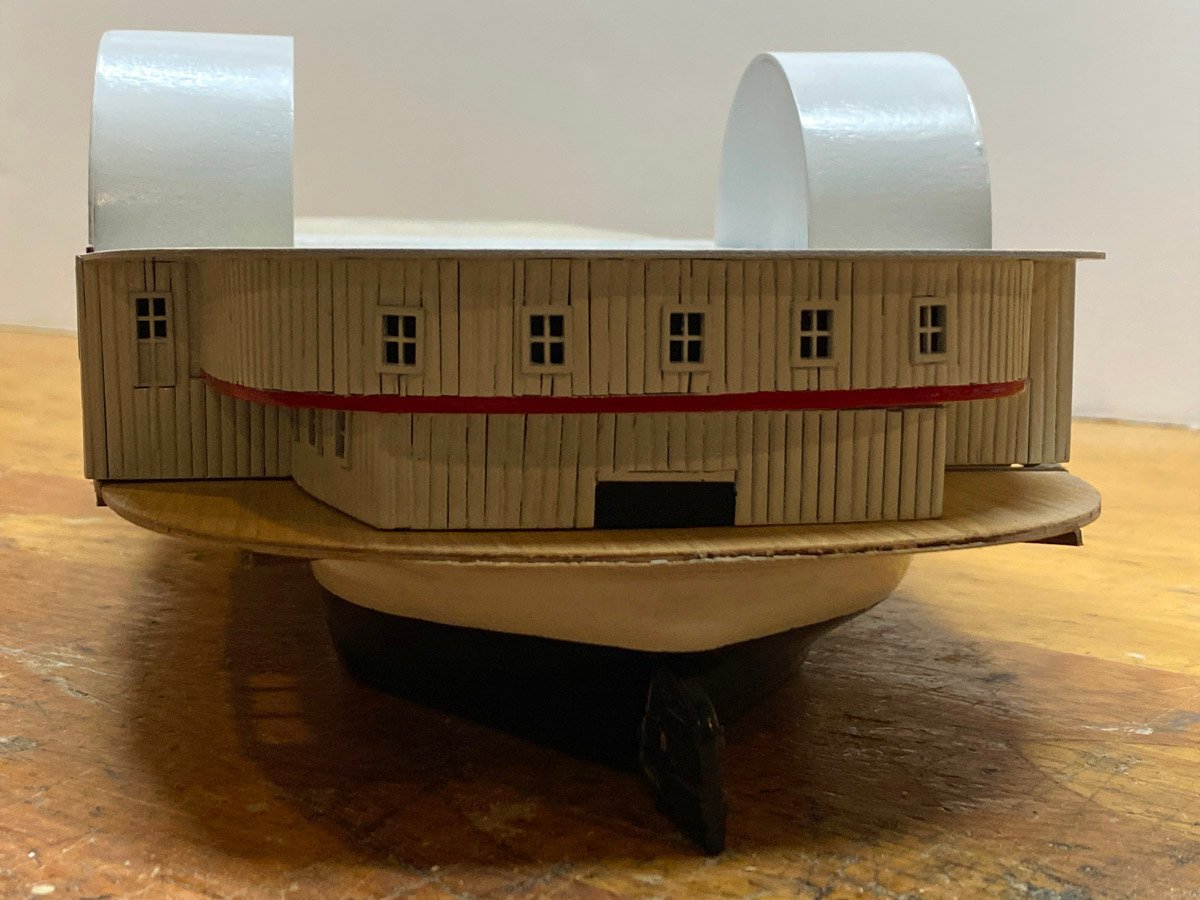
Rear cabins installed.

Everything completed so far. -
Bottom of the Hull
The instructions have you attaching the lower cabins, and then flipping the model over and planking the bottom of the hull. It seemed a lot easier to do the planking while the top of the ship was flat, so that's what I did.
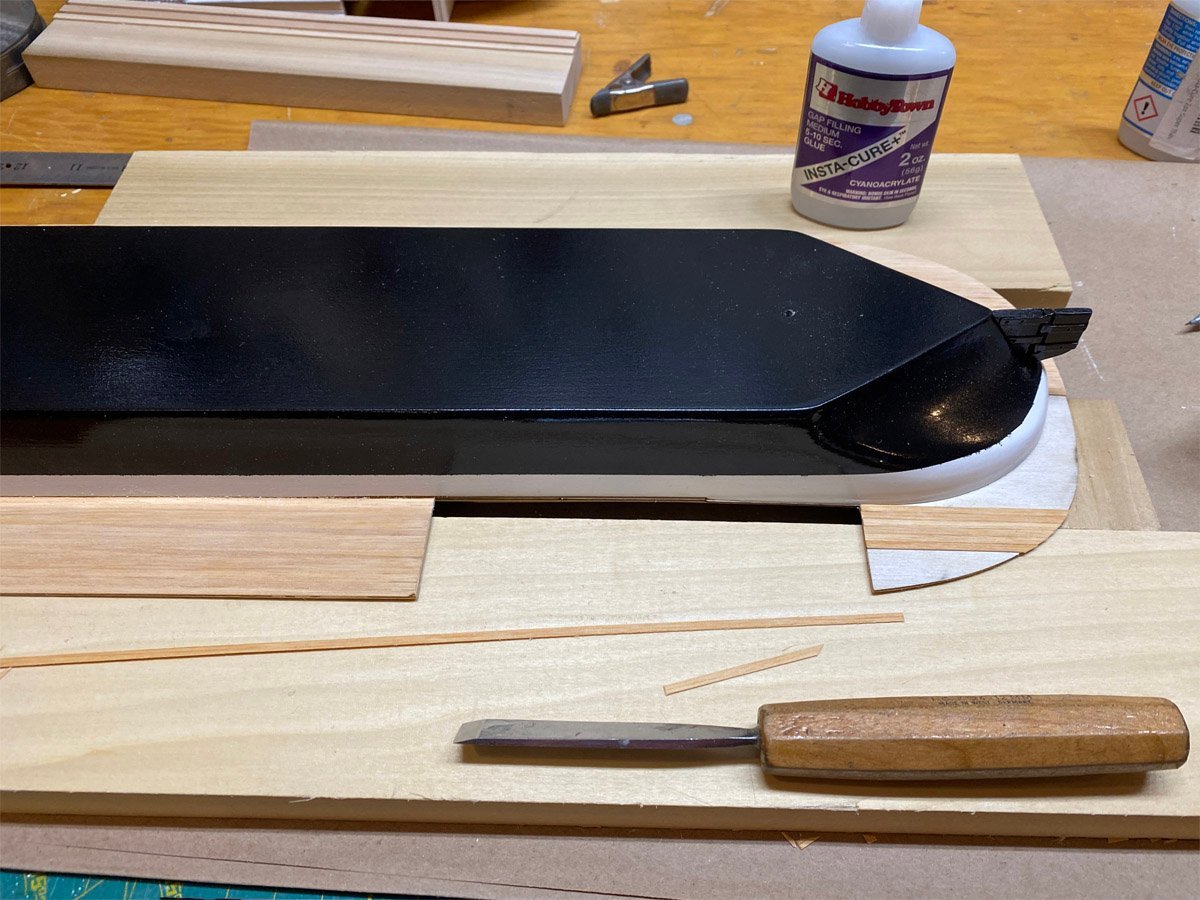
When the ship is on its stand you can't see the bottom of the hull, so I planked it with full strips and dispensed with the fake plank joints.

There are periodic braces across the planks.
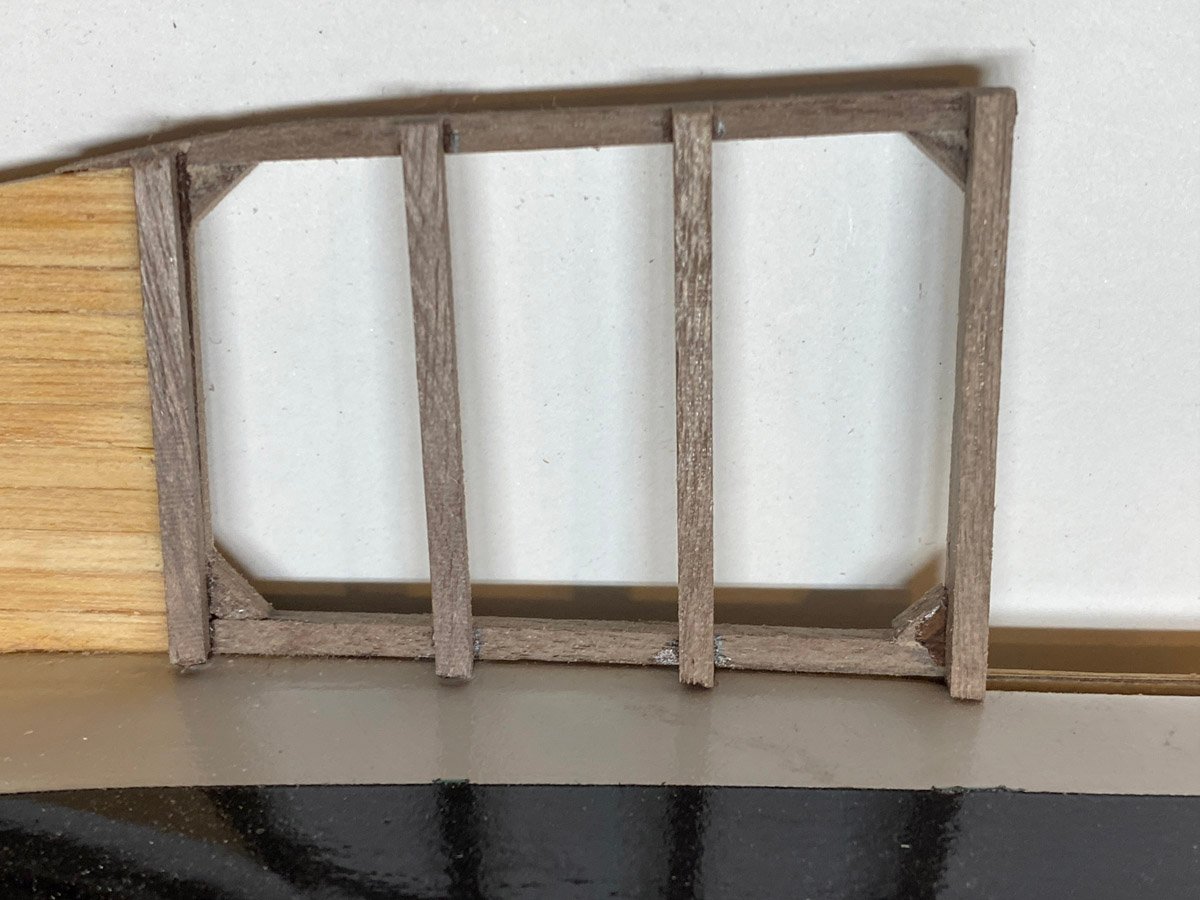
This grate sits behind the paddle wheels. It must have some hydrodynamic purpose, perhaps to give the water uplifted by the wheels somewhere to go. Anyone know about that?
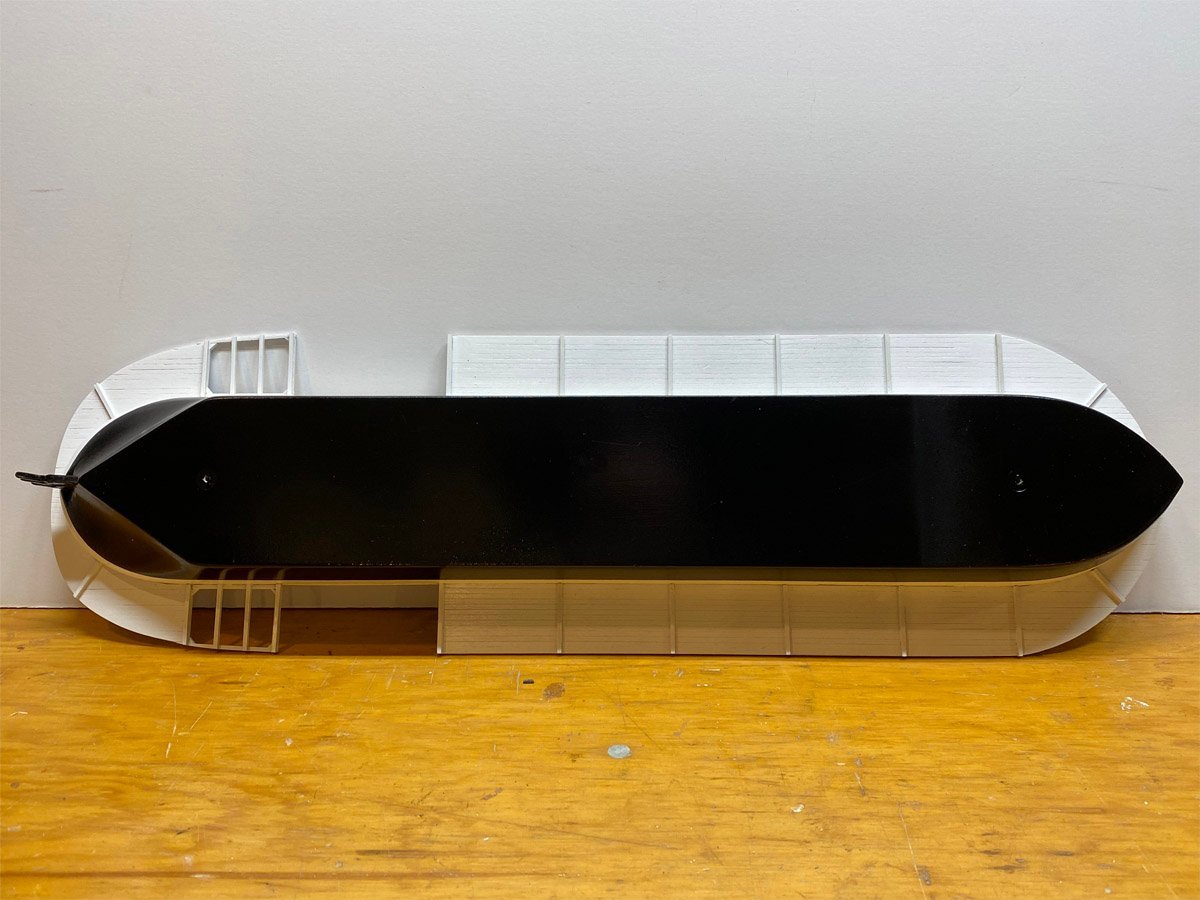
Everything gets painted white. I think that I like this look better than the chamfered edged planking on the cabins. I might dispense with the chamfers on the next layer.
-
-
On 7/21/2023 at 6:14 PM, Snug Harbor Johnny said:
'Love this steamer - and its a future project - since I discovered that the Scientific wood model and the Pyro/Lindbergh plastic version are the same scale - about 1:72. Thus neat detailed parts from the Pyro model can be used to enhance (and make easier) doing the wooden version by Scientific
Johnny,
This is a beautiful steamer and an interesting but difficult build. I didn't appreciate how big and complicated these old ships were until I started this model. At 1:150 scale the Amati kit is pretty big, but at 1:72 your Scientific/Pyro build will be a beast!
-
Colonnade
The boiler room and raised cabin are surrounded by a colonnade that support the deck above. Like most everything else on this model, the parts are assembled upside down on the roof. That is usually quite confusing, but in this case the colonnade was easier to assemble upside down. Here's the end product.
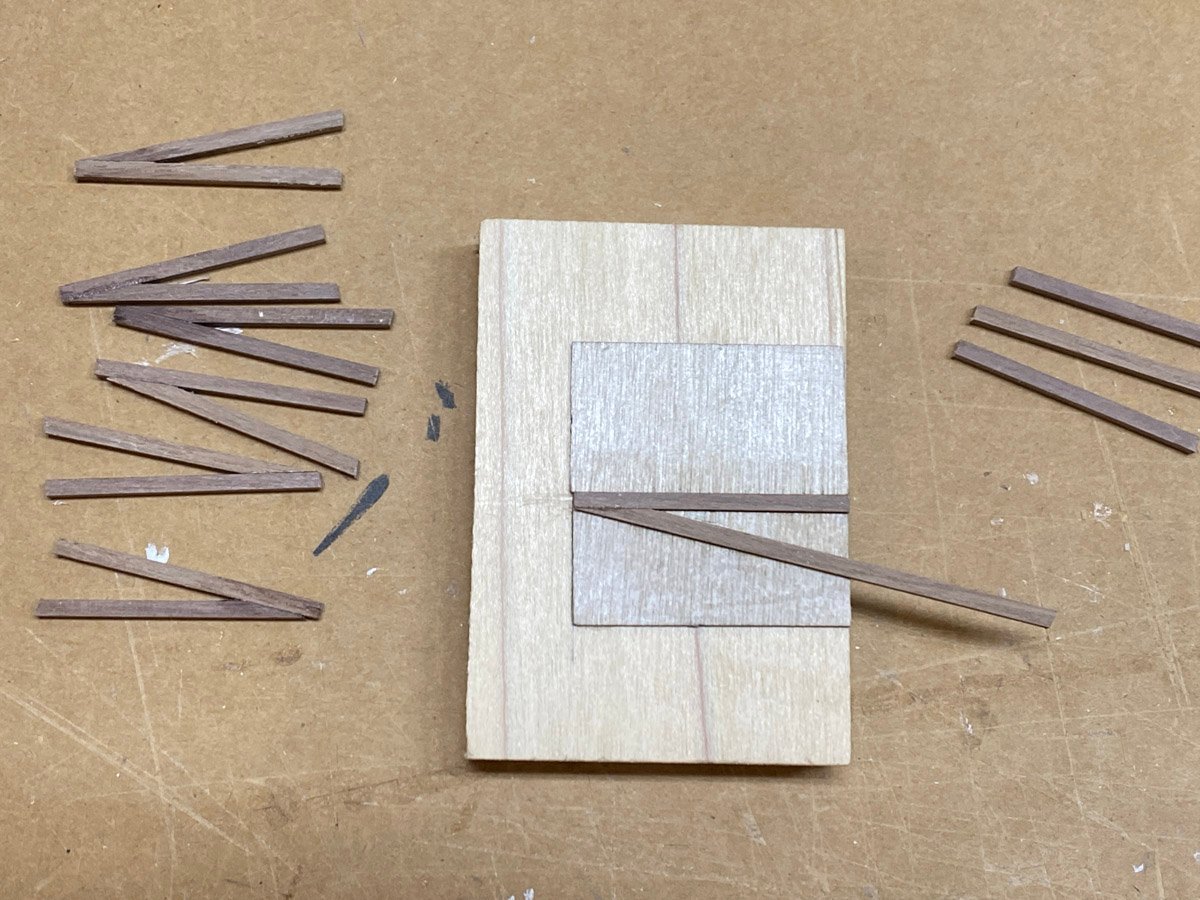
The braced columns are built in a jig made from laser cut parts. I stopped my jig flush with the base of the columns so I could flip it over and saw the legs off flush.
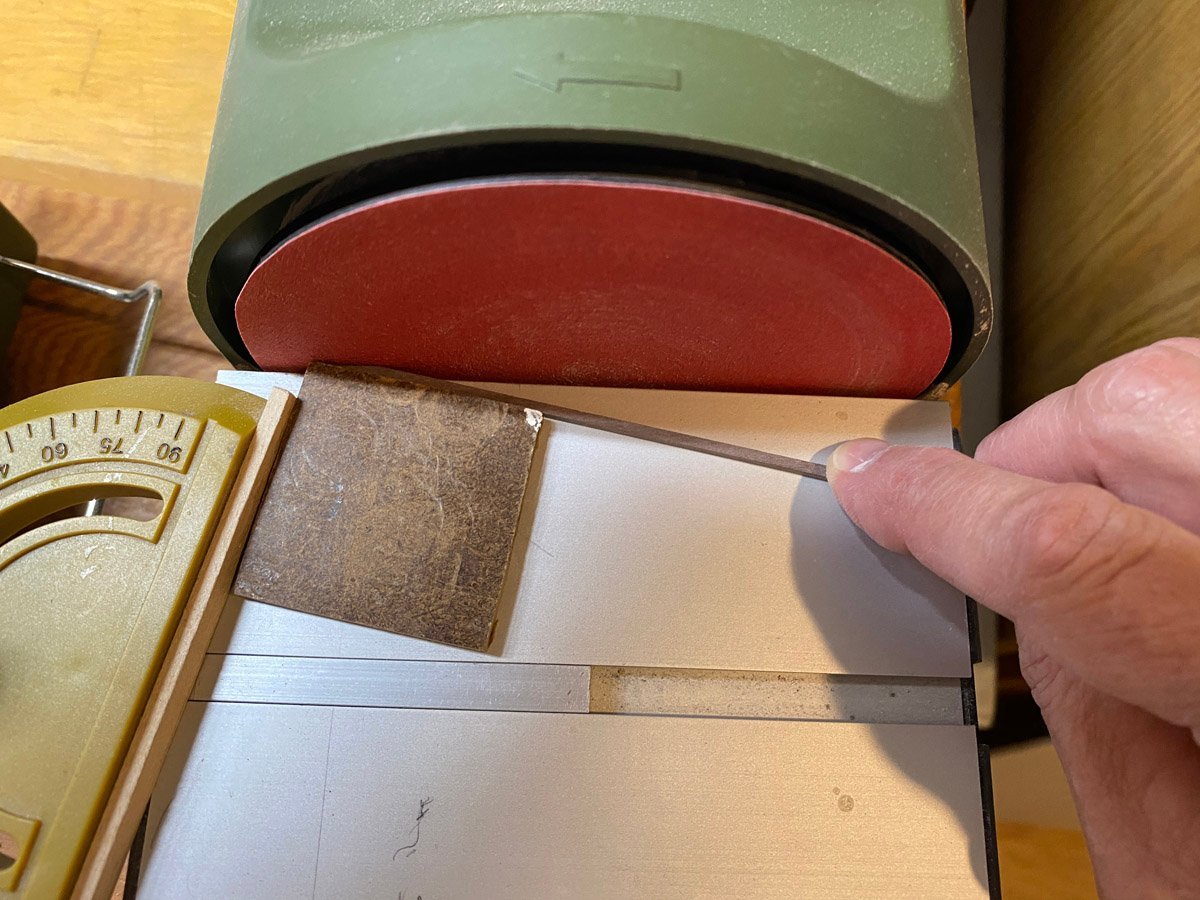
I sanded the braces to shape on my disk sander. The angle is 14 degrees - way too small for my fence - so I set the fence to 14 degrees and attached a square block as an auxiliary fence. I could sand perfect angles in a couple of seconds.
One big problem with this model is that the cabins are all made separately, upside down, using instructions in Italian with English translations, full-sized layout drawings, and a dimensioned parts list. Often the dimensions don't quite match up, and no matter how many times I look at the drawings it's never clear how the cabins are supposed to go together ...
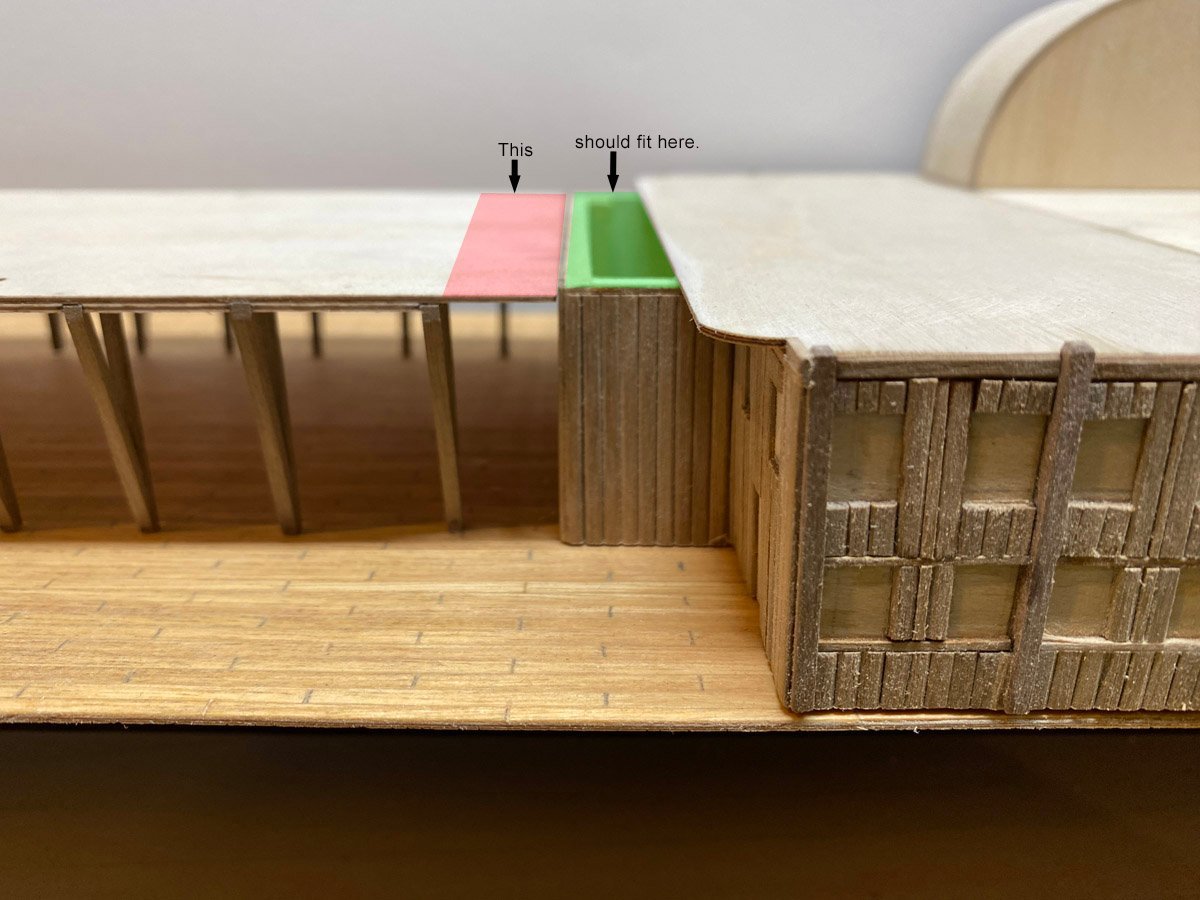
until it's too late. The roof of the colonnade is supposed to sit on top of the neighboring cabin, but mine was about 1 mm too short. I have no idea how that happened. My only recourse was to add a 1 mm square pad to the bottom of each column. It wasn't as painful as I expected, and it allowed me to shorten 2 columns at the bow to account for the slope of the deck there. Here's everything correctly aligned.
Almost everything needs to be painted white before I can do much more construction so it's off to the paint booth, AKA garage.
-
Boiler Room & Raised Cabin
The boiler room is a simple 3-sided structure with 8 holes in the front for brass portholes. The louvered sides are paneled with strips with a tapered cross section, except that the taper was too subtle. I glued 0.5 mm thin strips to the high edge to accentuate the taper. The raised cabin sits in front of the boiler room with its own deck on 6 pillars.
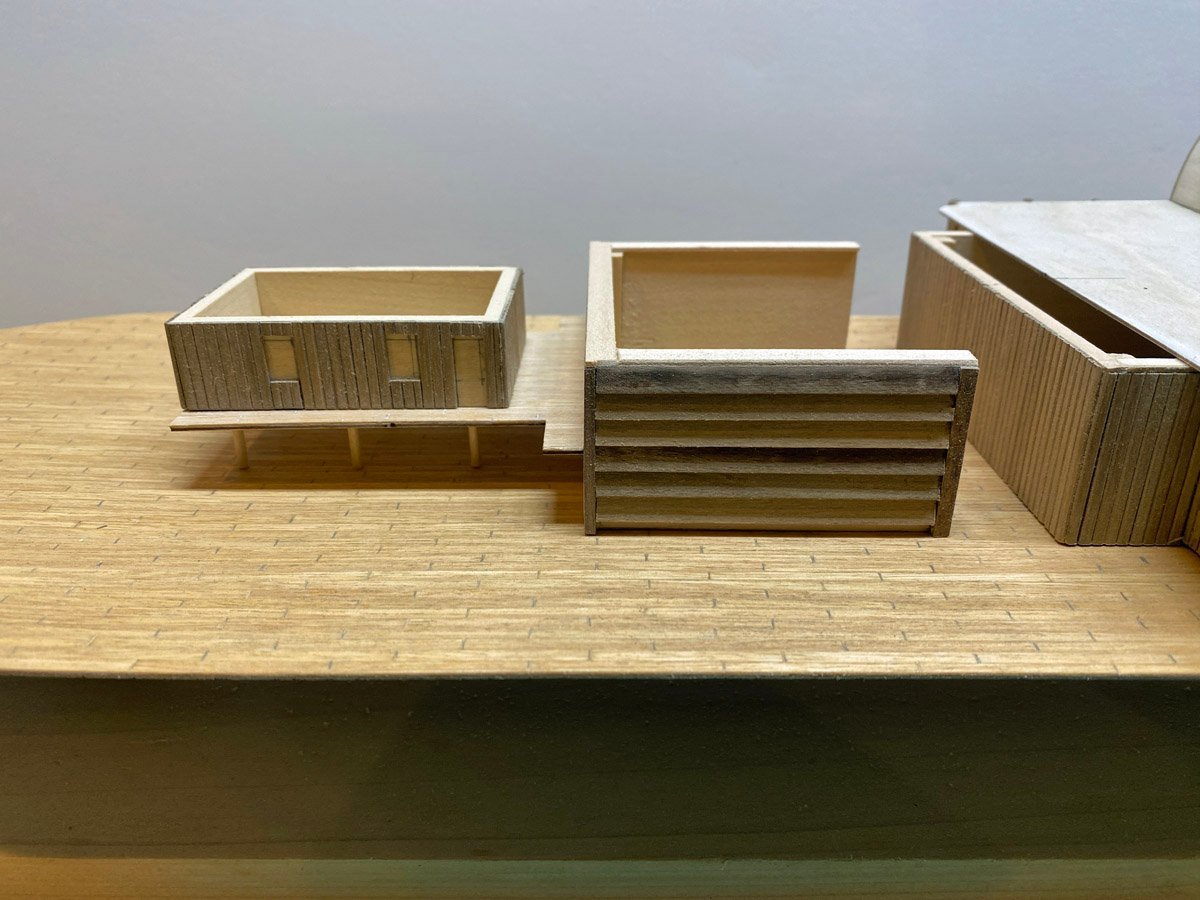
Raised cabin & boiler room in their eventual location.
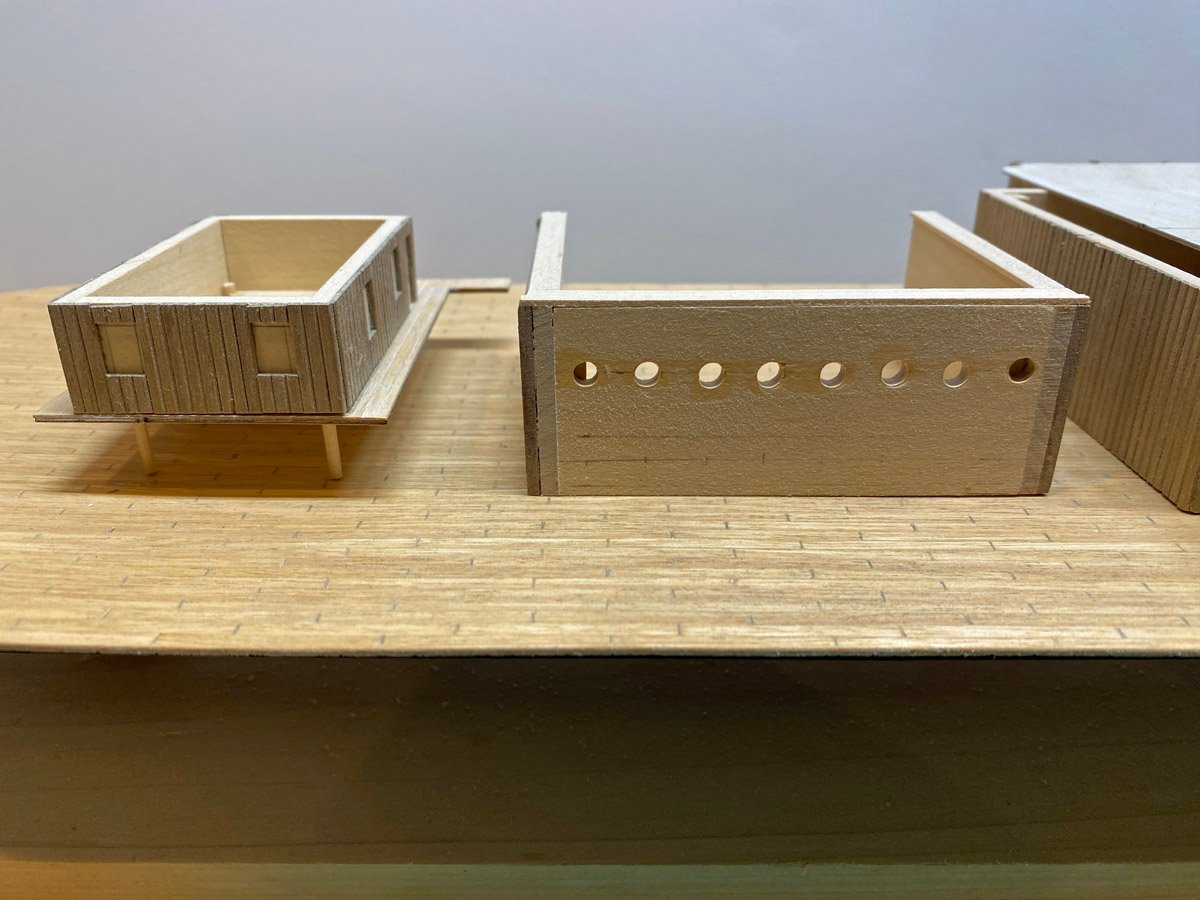
Front view.
- GrandpaPhil, Canute, yvesvidal and 2 others
-
 5
5
-
Hi Harry,
I just noticed your updates on the Sanson, and I will be following along. Your Before and After are impressive! Everything is looking much better. And everyone loves a tugboat. I am sure that your friends will like it better than the Bismarck, even if it is a much easier build. At least that's how it goes with my models.
Rod
-
Tired of Paneling Around Tiny Windows? Do this Tonight - It's Genius!
No, this is not click-bait. I did find a much better technique to fit panels around my tiny windows and doors. I borrowed the technique from marquetry where you glue up smaller pieces on a paper backing. I use medium CA to glue several sticks to thin brown paper in appropriate widths. Then I use a sharp chisel to cut the lengths to fit, 2-5 mm around the windows. The chisel leaves a nice square edge.
How to pick up the tiny pieces? I have a huge roll of 3M double sided tape. I attach tiny pieces of tape to a stick and use that to pick up the panels. It only sticks for a few pieces, but I can replace it in seconds. Smear some CA on the panel and drop it in place.
After I had all the edging in place, I paneled around all these windows in an hour or so.
- hof00, schooner, GrandpaPhil and 2 others
-
 5
5
-
Planking the Cabin Walls
The kit supplies 1x2 mm walnut strips for planking virtually every surface of every cabin. The planks have to be fit around approximately 130 cast metal windows and 22 doors. This often involves cutting strips 3-5 mm long for the spaces above and below the windows. Now I know why several people never completed this model!
Much of the model will have white walls and white windows, but the area behind the windows should be black. So I will have to spray paint the walls and windows white, but hand paint inside the window openings black before assembling. The upper cabins will have natural walnut walls which will have to be sanded, edges beveled, and stained before planking.
Here is my first go at cabin walls, with a door and some windows dropped in place.
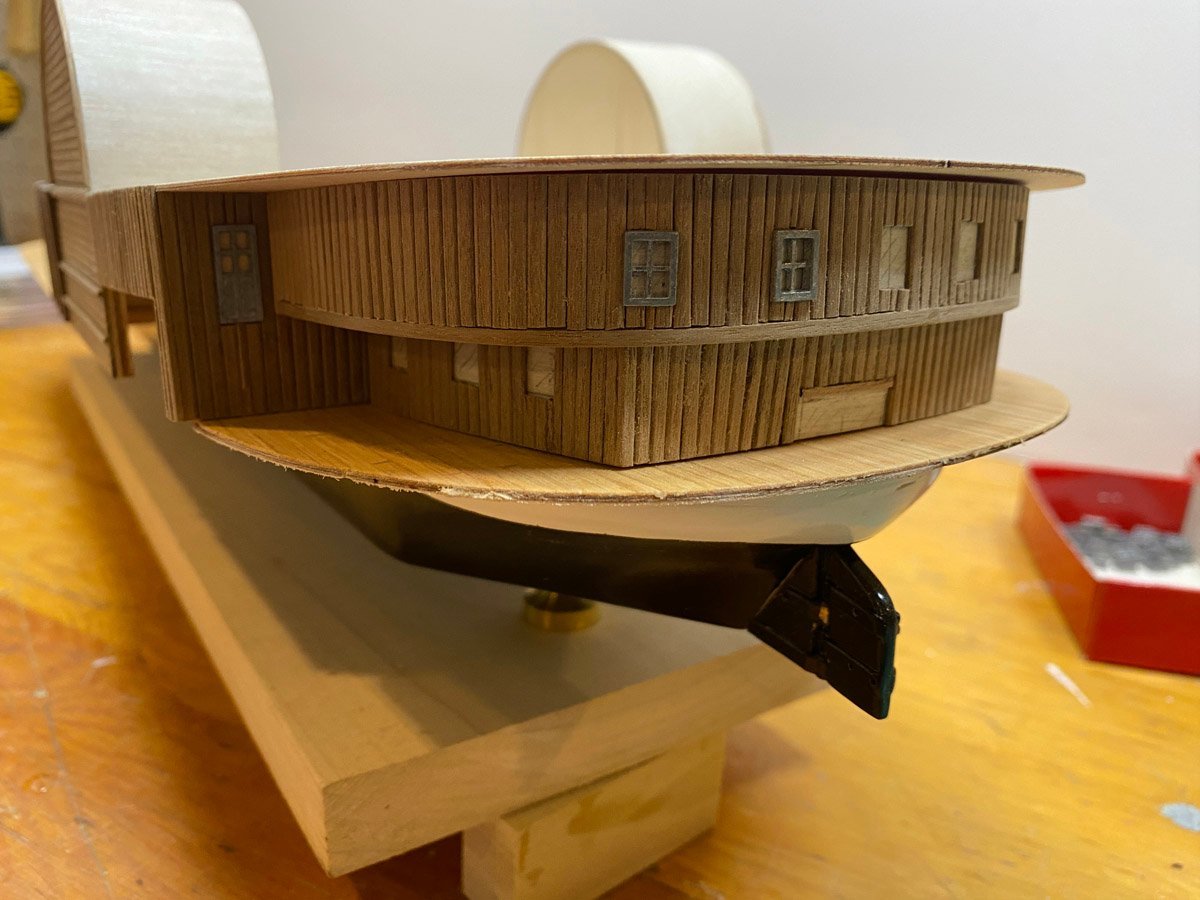
I am getting better at planking using the following techniques:
- Chisel a clean edge on a long plank to get a tight fit against one edge.
- Apply CA to the back of the plank, wipe excess, and lay in place.
- Cut the long end of the plank with flush cutters.
- Sand remaining edges towards the plywood backing to minimize splinters.
-
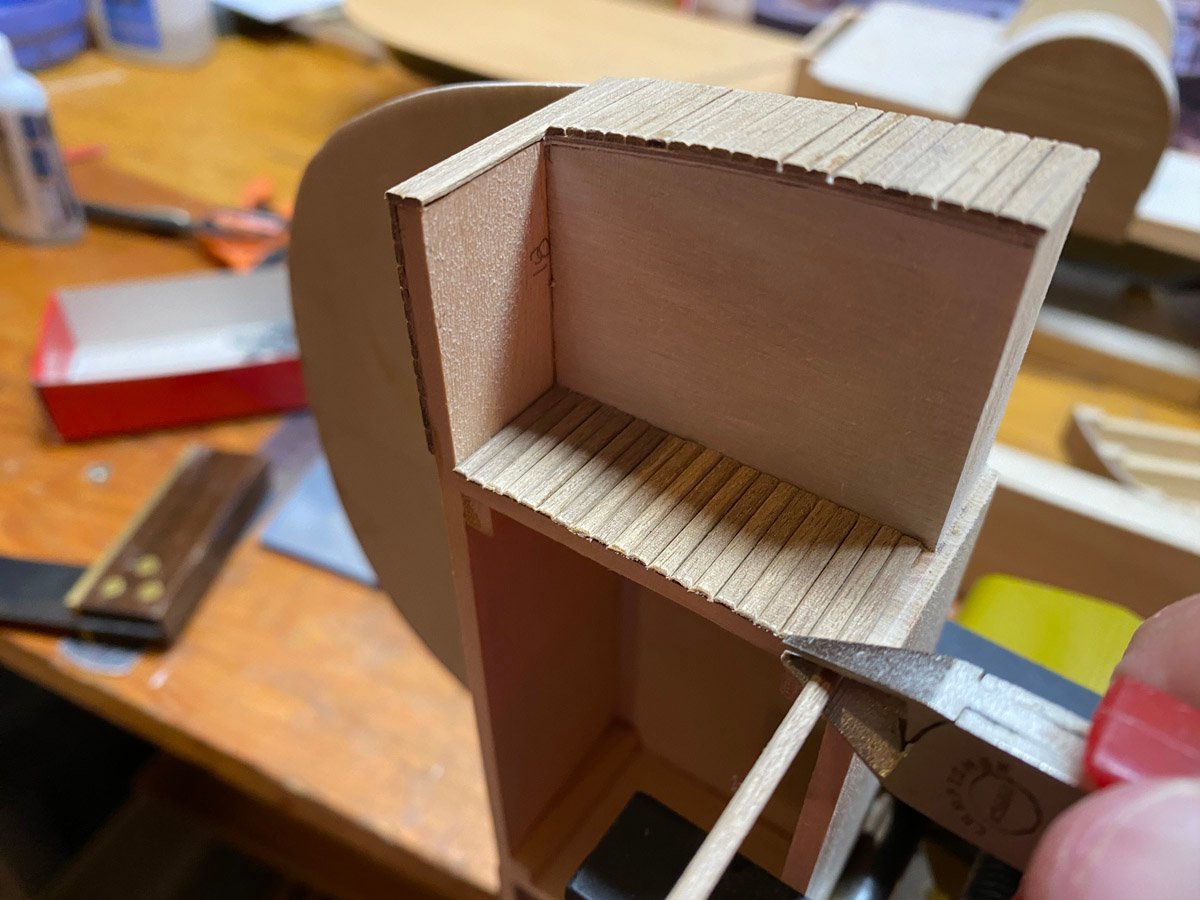
-
Planking the Deck
The kit supplies 1x3 mm oak strips for the deck, top and bottom. I stained all the strips first with Watco Natural oil stain. That way if I get a little sloppy with the glue it won't interfere with the stain.
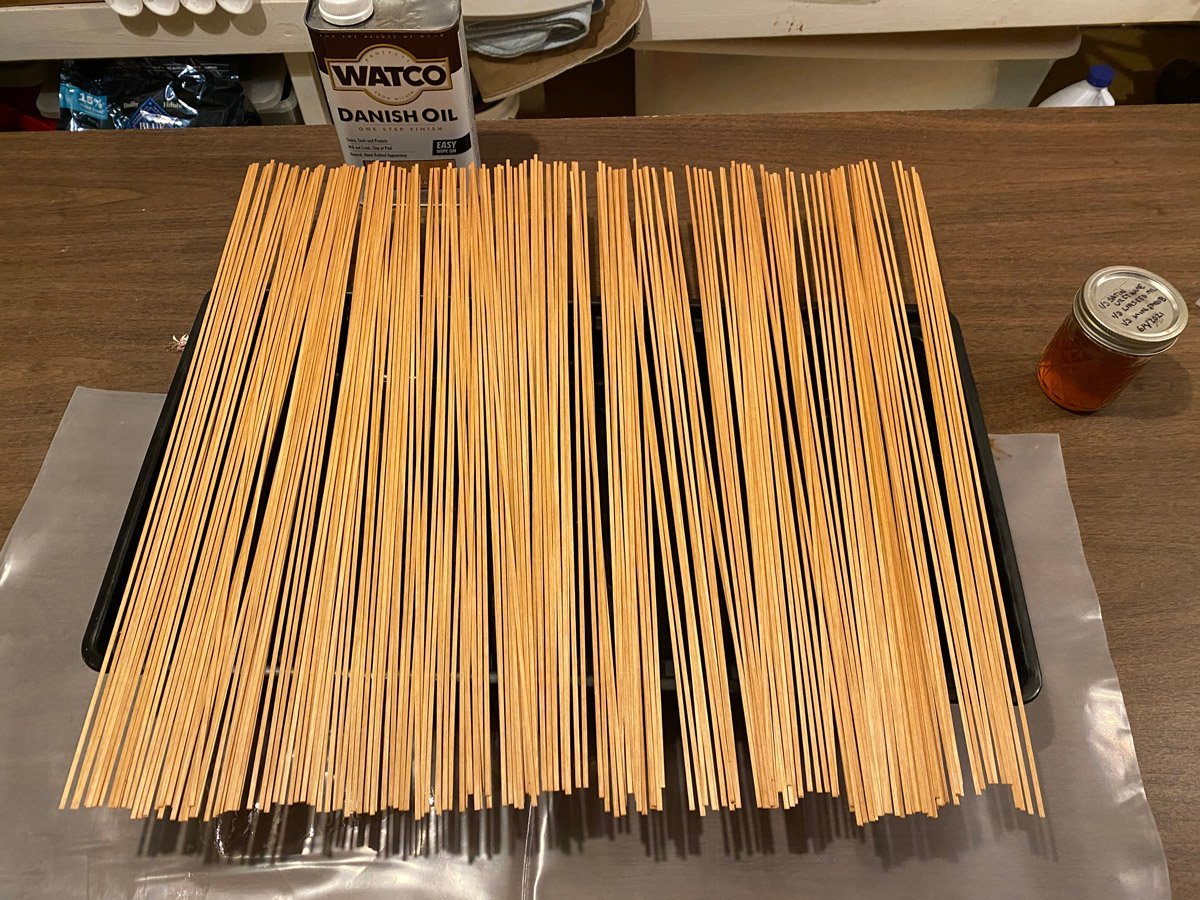
I made the planks 30 mm long, which scales up to 4.5 m or about 15 ft. I don't actually cut all the little planks. I glue down a full strip with CA, then chop the joints between the planks with a sharp chisel. My chisel is much wider than the planks so I do one strip at a time and let the chisel hang over the edge. I staggered the joints over three strips - very convenient 10 mm stagger. After I get some cutoffs I use them instead of full strips.
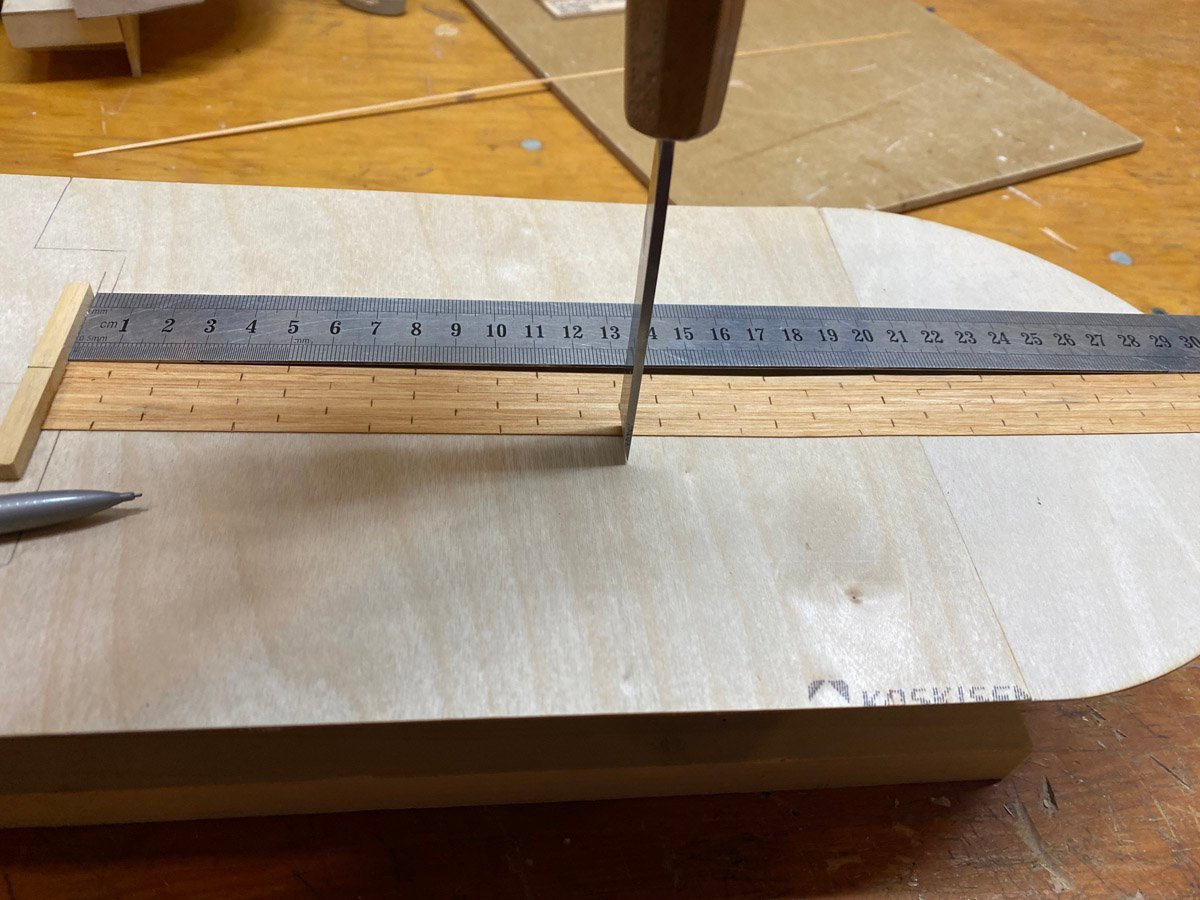
I coated the completed deck with Famowood wood filler, sanded it smooth, and stained it again with Watco. The whole deck only took a couple of evenings. Here's the final deck with some of the structure on top.
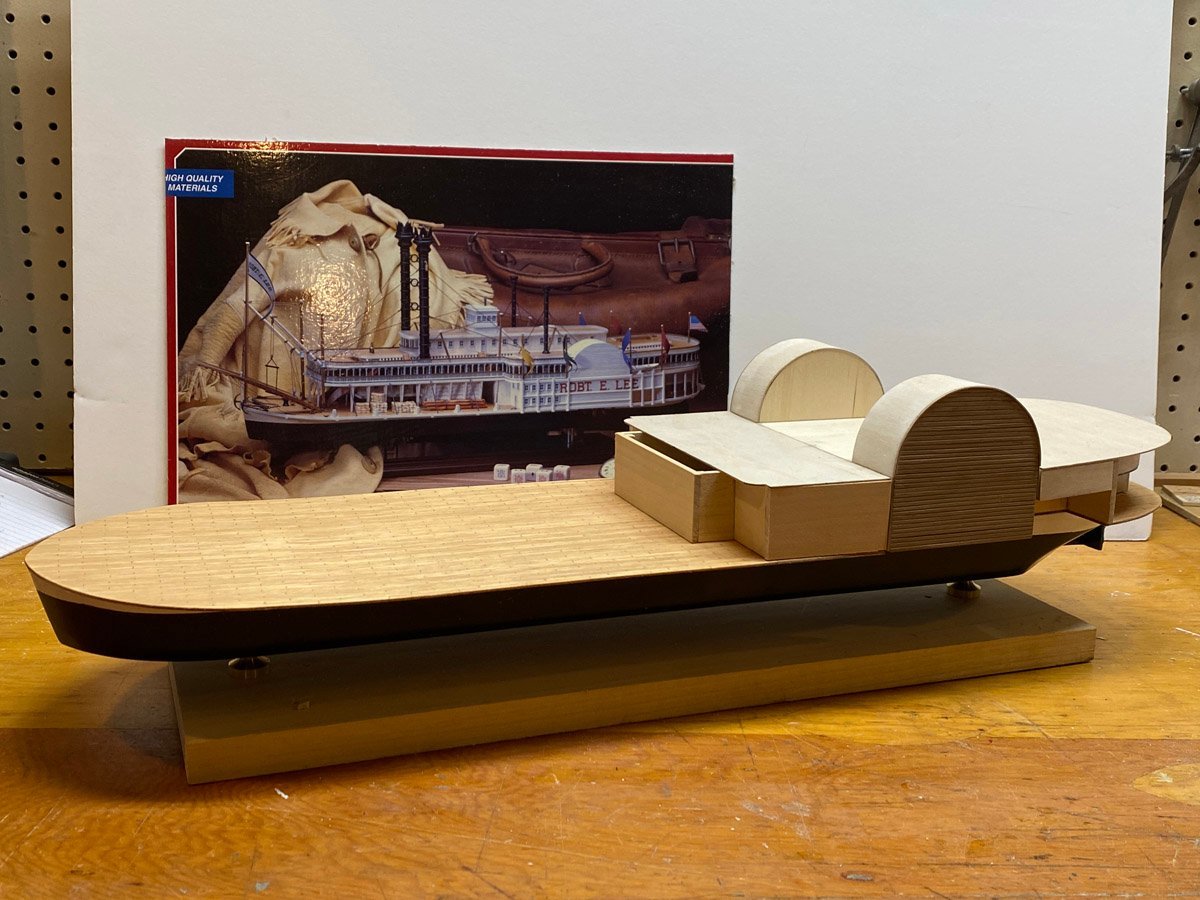
- Nunnehi (Don), Canute, yvesvidal and 3 others
-
 6
6
-
-
Eindride,
I tried to comment a few days ago but it seems like the post did not take.
Your work is beautiful! I love the carving on the bed headboards.
But I think that you have made a mistake on the niddy noddy. The end pieces should be perpendicular to each other and not in the same plane. Then the yarn is wound as in the attached photo. I wonder if the Oseberg niddy noddy was crushed in the burial.
My wife is a (former) hand weaver and spinner, and has done a lot of research on Vikings for a couple of recent novels. She informed me that the small wooden containers in the Oseberg burial contained cannabis seeds.
I built the Billings model of the Oseberg ship a few years ago. There should be a link to gallery photos in my signature file.
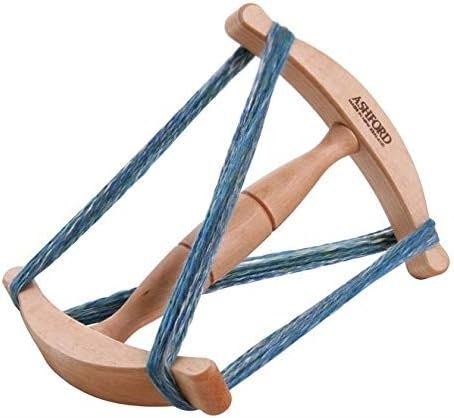
-
On 7/7/2023 at 7:22 AM, schooner said:
Your photo reminds me of something unexpected I recently learned - the MinWax stains you show in the lower right of your photo match what I've encountered coming straight out of the can but if I stirred them (not shaken) the colors change dramatically, e.g the Ipswich Pine goes from the light transparent yellow to a solid dark-medium brown. The can directions make no mention of either stirring or not stirring it prior to use.
I've decided to leave well enough alone- that way I know that I'll get something that looks like the color on the label.
Tim,
That's an interesting observation. I always stir stain before I use it but for those samples I might have used a quick dip. I probably should redo the Minwax samples.
Rod
-
Next Step, Deck Planking
I've been keeping a bag of paint and stain samples from previous models, all labeled on the back. It really comes in handy when I need to paint or stain a new model. I think I'll try Watco natural (large sample near the center) on the decks of the R. E. Lee.
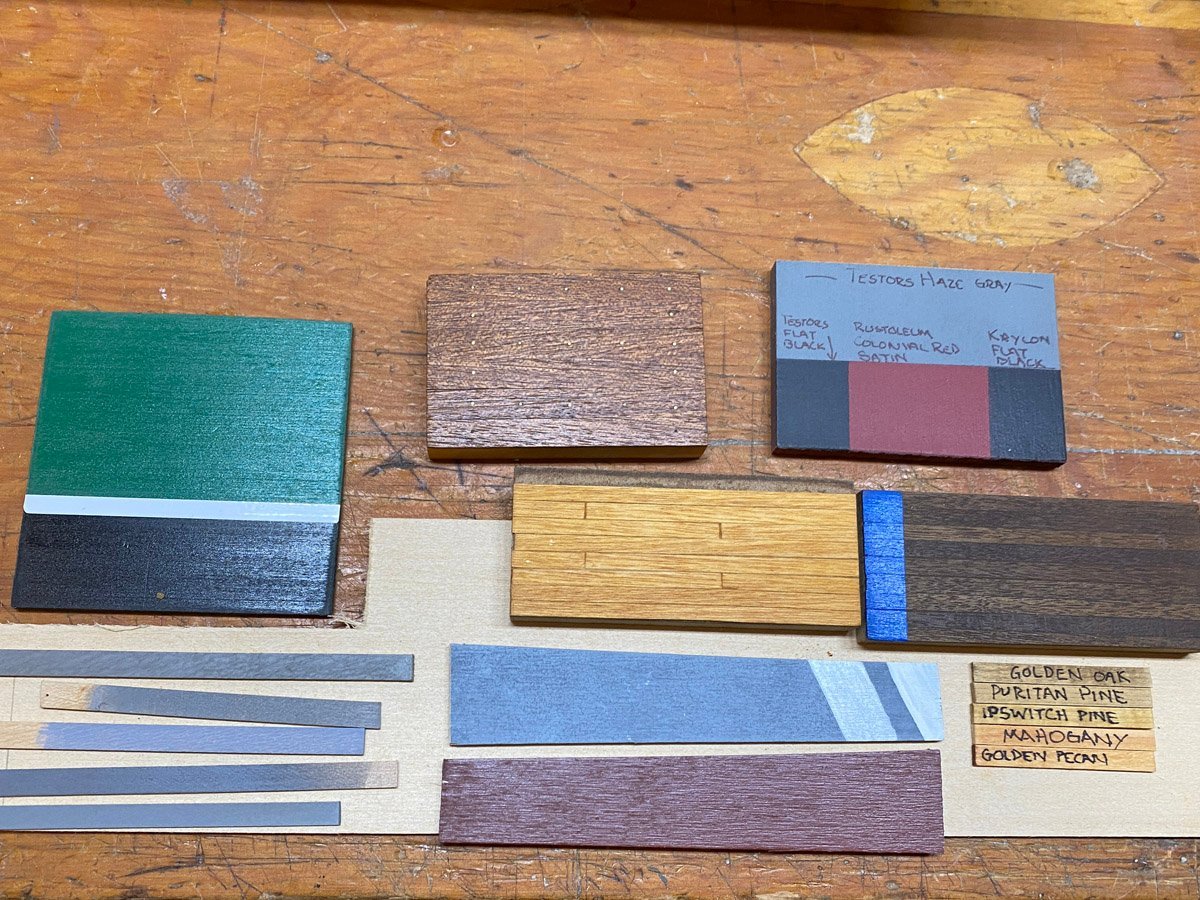
-
Big Wheels Keep on Turnin'
The paddle wheel rims are white metal castings that only required minimal cleanup. The instructions called for the paddles to be cut from 1 mm stock, but the notches in the rims were about 1.7 mm, so I made the paddles out of 3 x 1.7 mm planking left over from an old model. I painted the rims and long strips of planking before assembly, then cut the painted planking to length.
Sorry, no photos of paddle wheel assembly. Here's the gist, all done with CA.
Drill a 5 mm hole in a scrap board to hold the axle, then glue one rim perpendicular to the axle.
Cut 4 paddle spacers to exactly the distance between the rims, and use them to hold the second rim to the axle while gluing.
Cut 2x16 paddles to length and glue 13 of them to each wheel. You have to leave 3 off until the wheels are installed over the wheel brackets some months from now.
Sand and paint the ends of the paddles.
-
-
Paddle Wheel Housings
The paddle wheels are white metal castings that I will get to soon. The wooden shafts will be inserted into brackets inside the paddle wheel housings. The plans (which are approximately 94% scale) call for the brackets to be made from 1 mm strip wood. That just seemed too thin to keep the wheels securely in place and allow them to rotate, so I made them from strip about 1.7 mm thick. The paddles will have to be correspondingly smaller.
The paddle wheel shaft will fit in this slot and be stopped with another piece.
The outside of the wheel covers are planked with 2mm walnut strips. That seems very narrow, but at 1:150 they scale up to 1 ft. boards. That's a big board today, but maybe not in 1866. I borrowed this technique from Rodgerdodger to sand the planks and put a tiny bevel on the edges.
The jig has 2 slots.
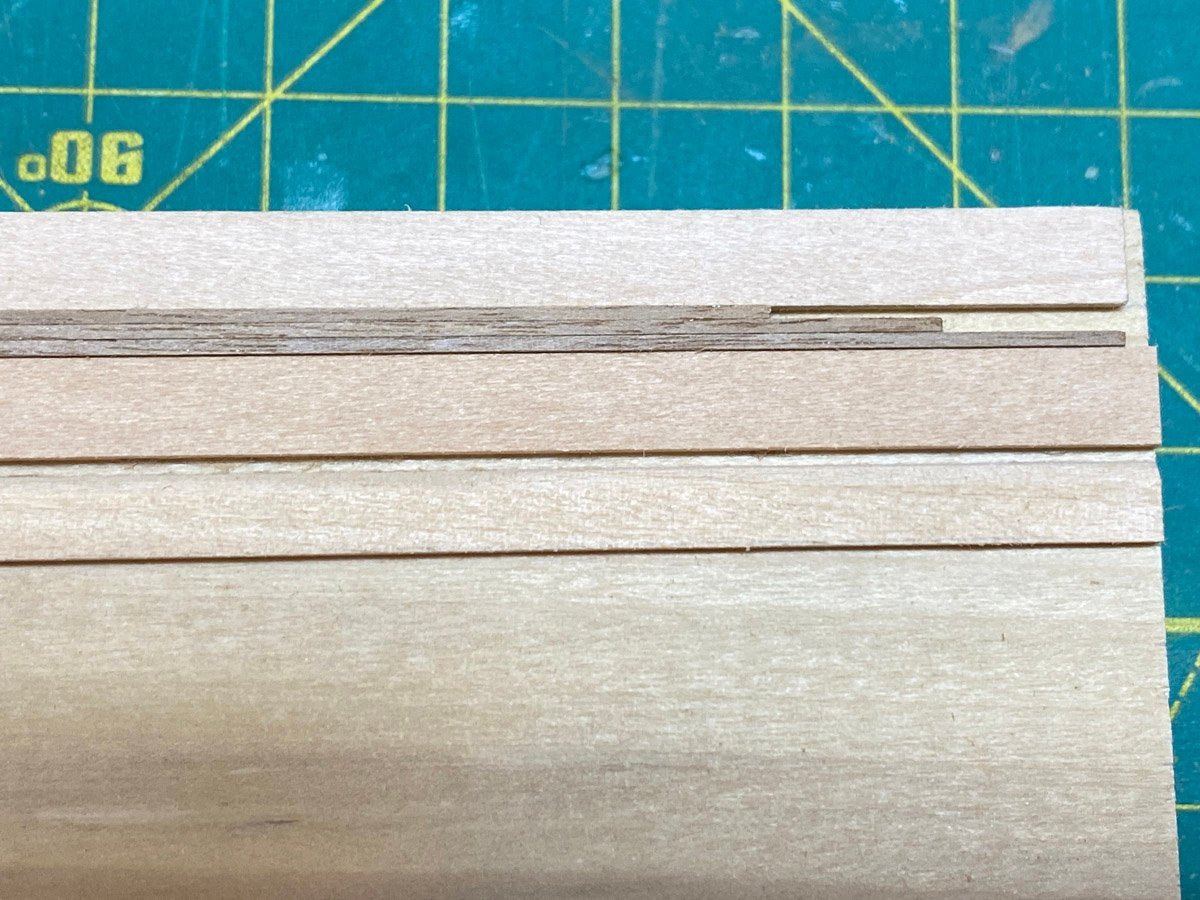
The top slot holds 3 strips while I sand the edges flat.
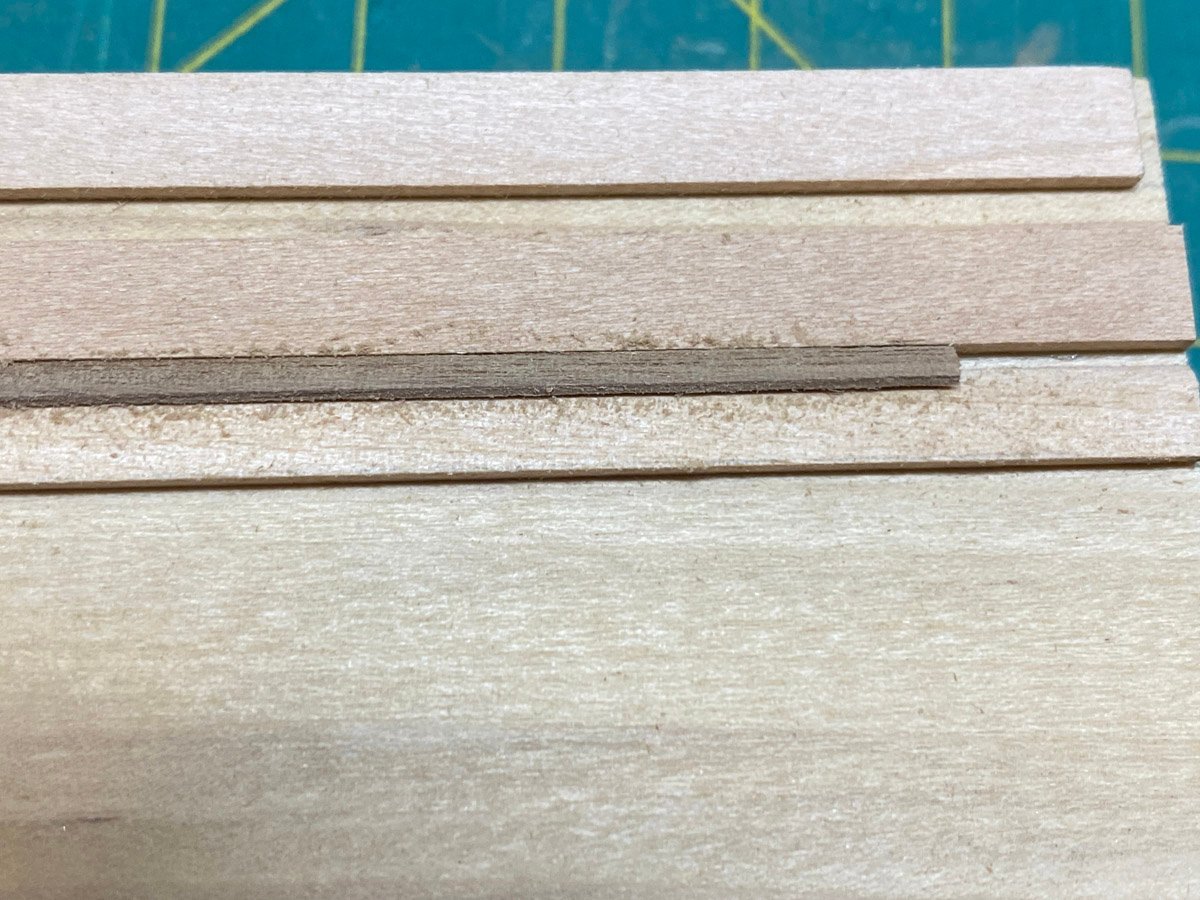
The bottom slot holds 1 plank at a 45 degree angle while I bevel the edges. It seems like a lot of work but I can sand and bevel three 20" planks in 5 minutes.
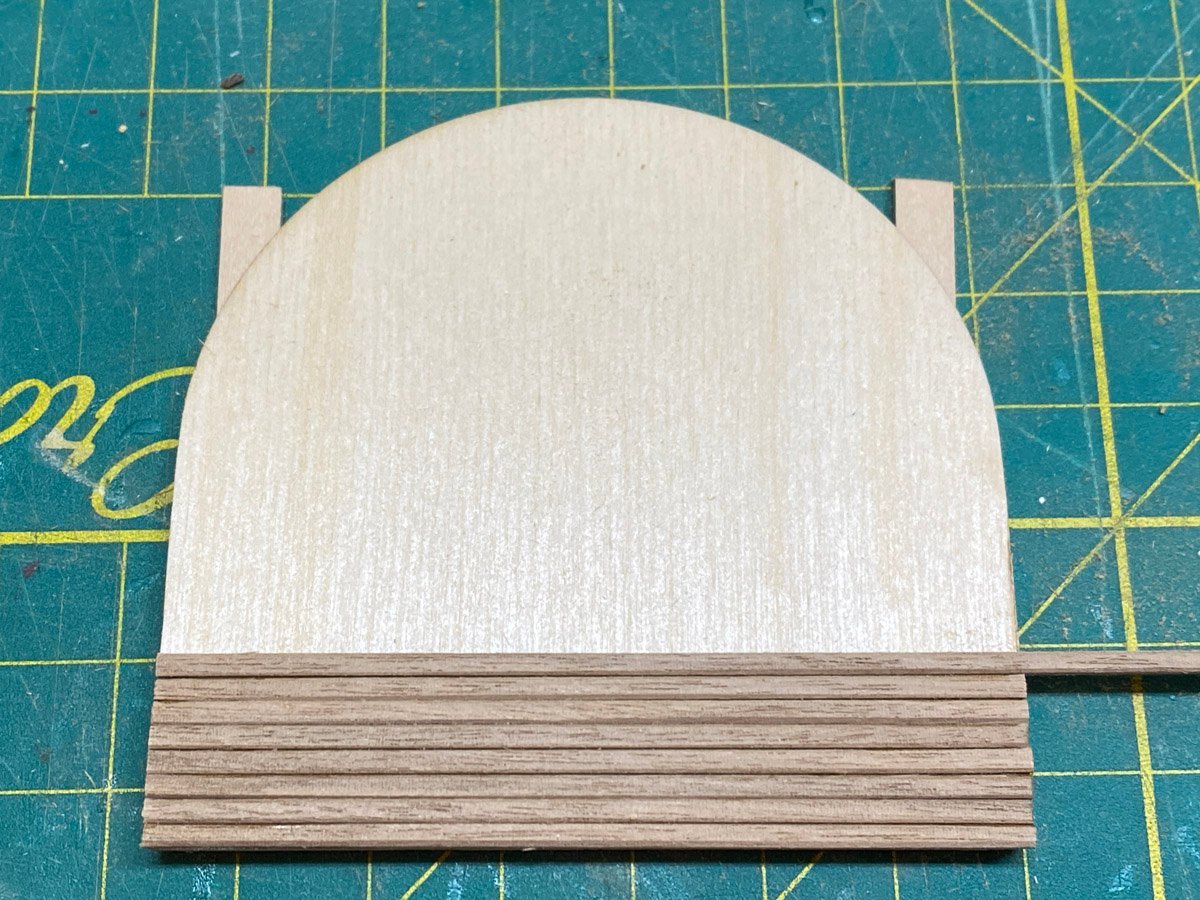
Here are some planks glued to the wheel covers. Using CA I can glue a plank and trim the end with a chisel in a few seconds. I love the look of the beveled planks. These pieces all get painted white, but other cabin walls will be stained natural.
Here two wheel housings, one planked and one plain, are held apart by spacer blocks clamped in place like an ice cream sandwich. The sandwich gets skinned with the 1mm ply sheet at the bottom of the picture glued with CA. The whole assembly took a couple of minutes.
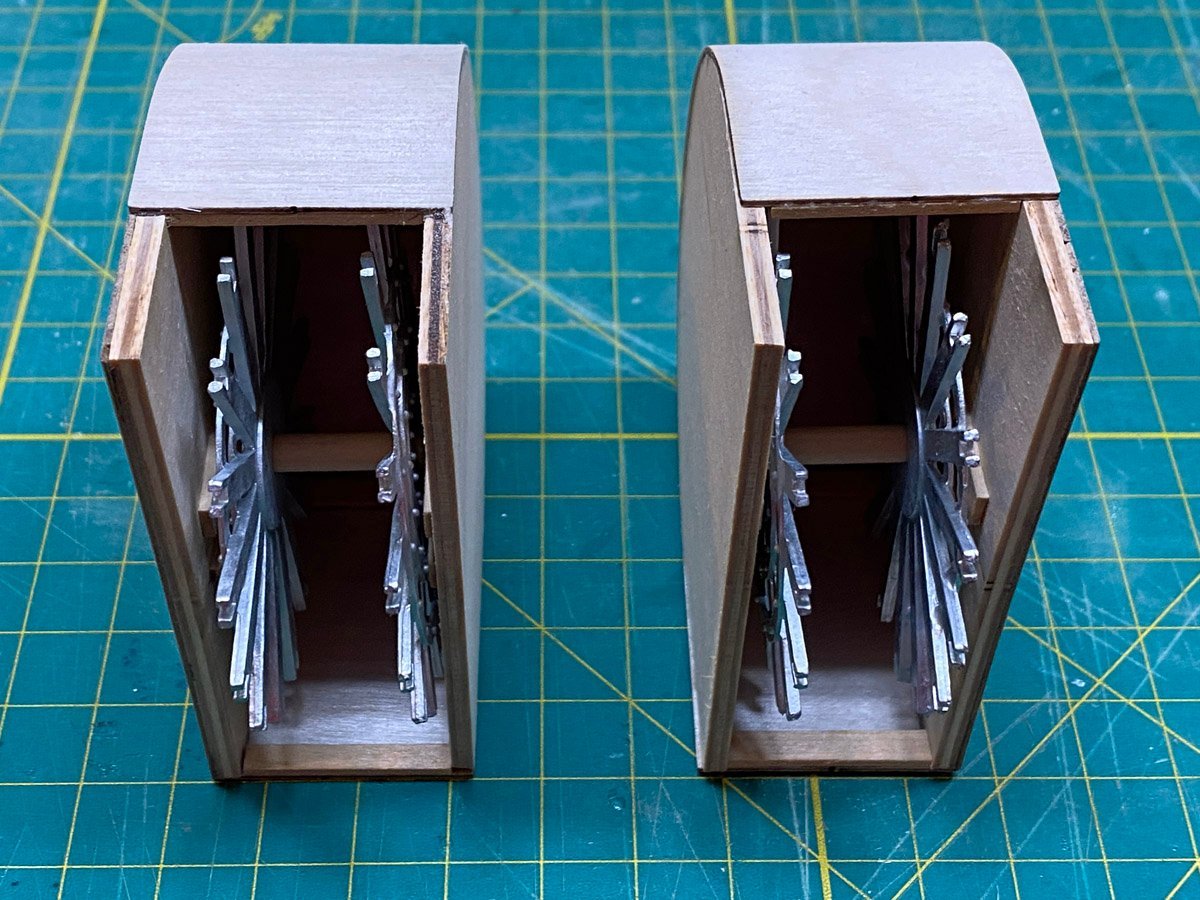
Finally, here are the two wheel housings with the wheel spokes in place to check the fit. The aft skin stops short of the bottom of the housing.
-
Cabins
The build log by rodgerdoger linked above has already been a huge help. Rodger noted several errors in the plans that have already bit me. Parts are mislabeled, drawings are confusing, drawings that are labeled in Italian "Scala 1:1" are actually about 94% full size, and laser-cut decks that should be the same shape don't match.
Cabin structures are built starting from the stern from flat stock attached to the bottom of the next deck piece above, then skinned with laser-cut plywood. First problem, the cabins are mislabeled in the instructions. I've corrected that in red below.
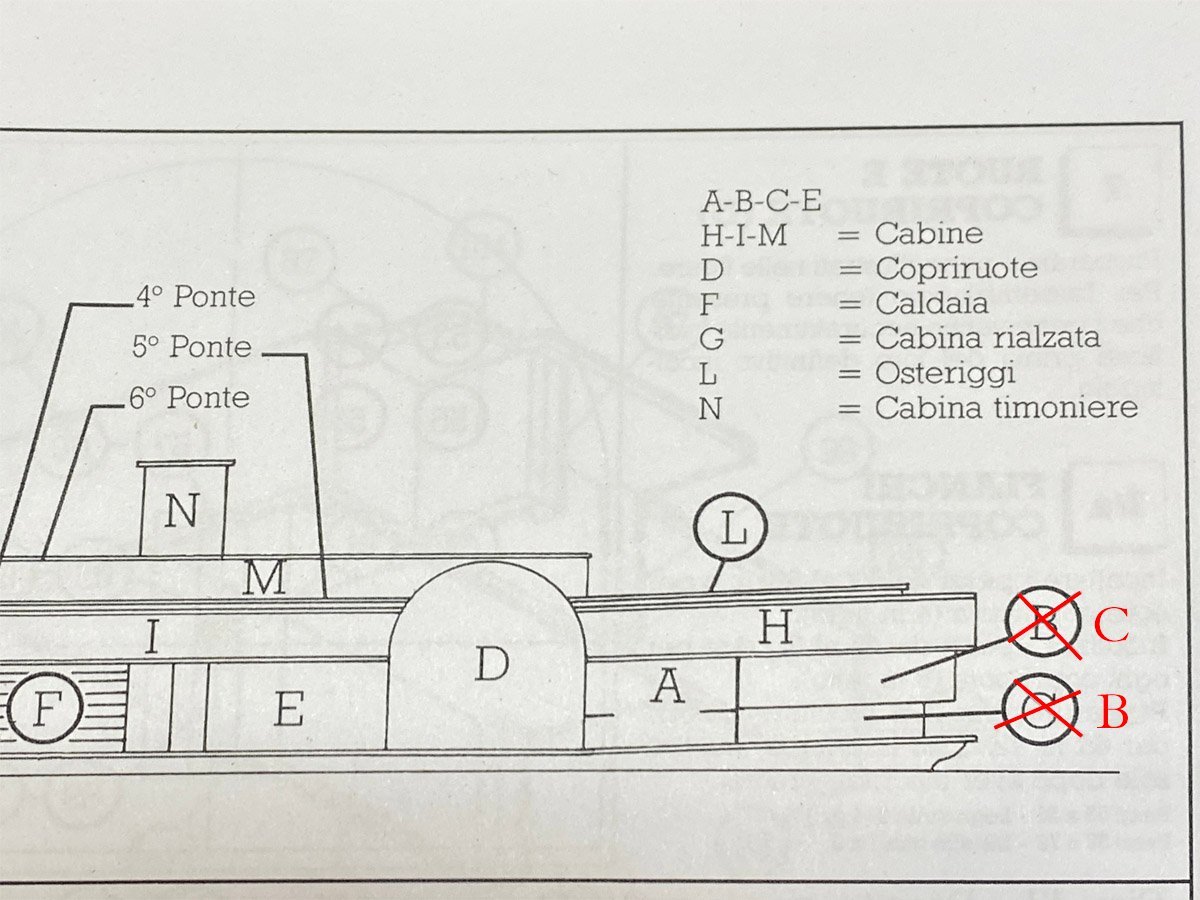
I built the cabins in order, A, B, C. The flat stock for A & B was exactly the right height. The plywood skin for C seemed too wide, so I trimmed off about 4 mm to make it flush with the frame. And then I realized that B+C<A, by about 4 mm.
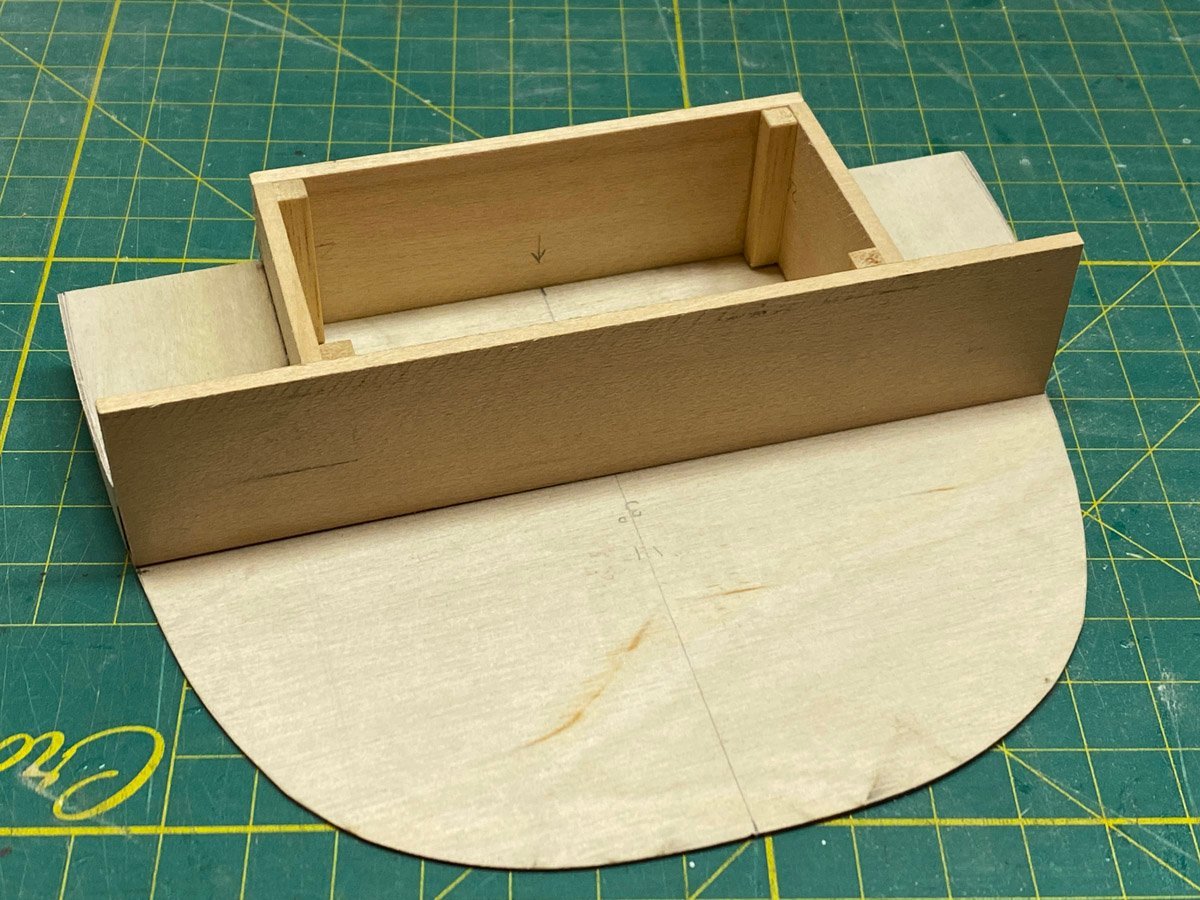
Cabin A.
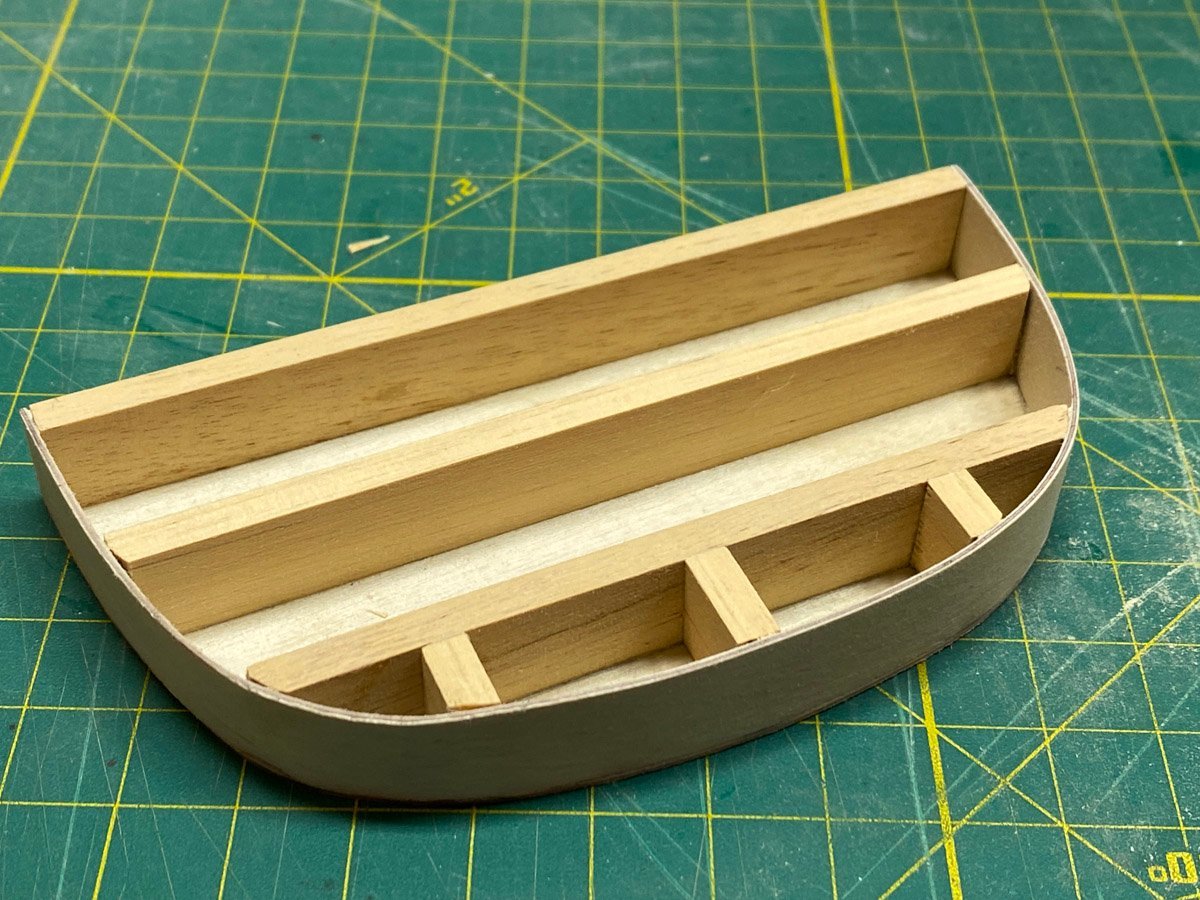
Cabin C skin incorrectly trimmed flush with frame.
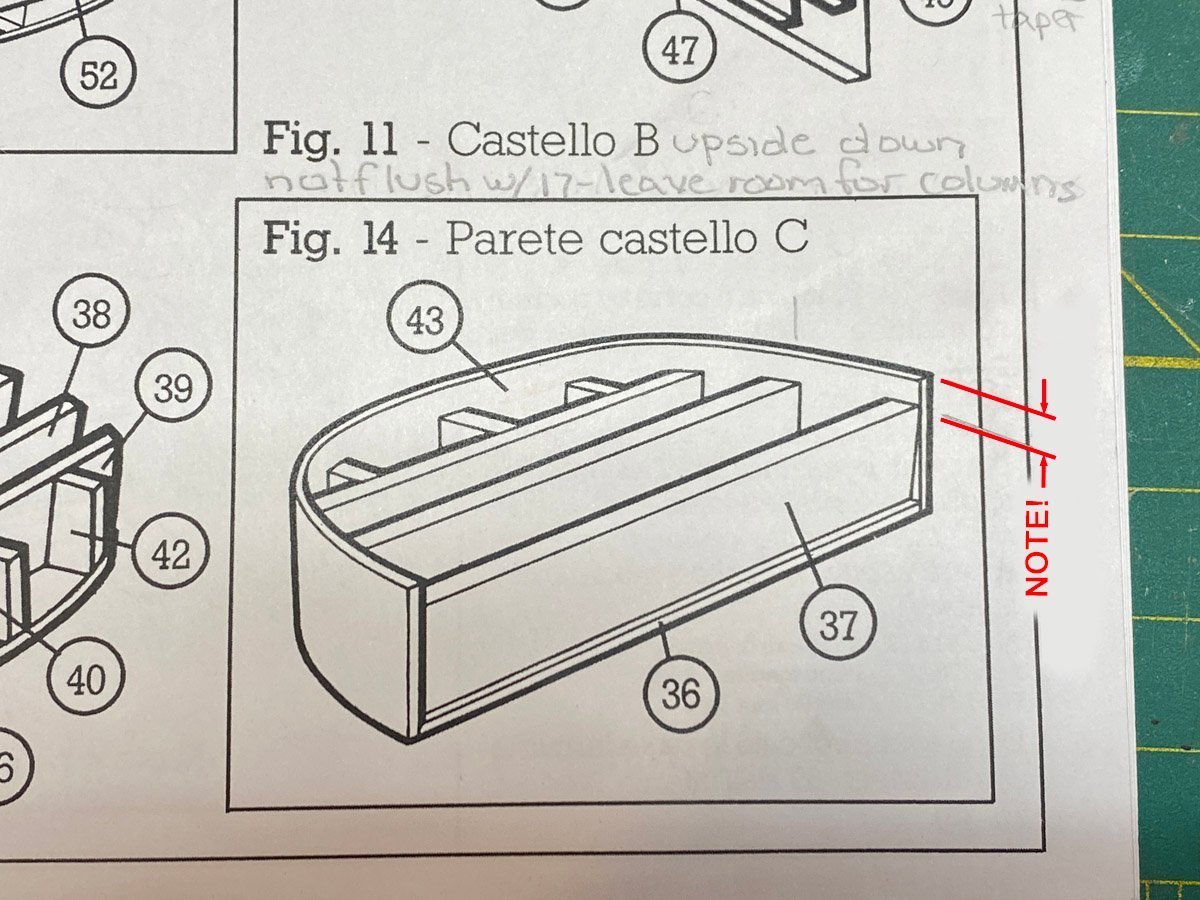
Cabin C plans show skin taller than frame. Luckily I saved the cutoff, so I added some support blocks and glued it back on.
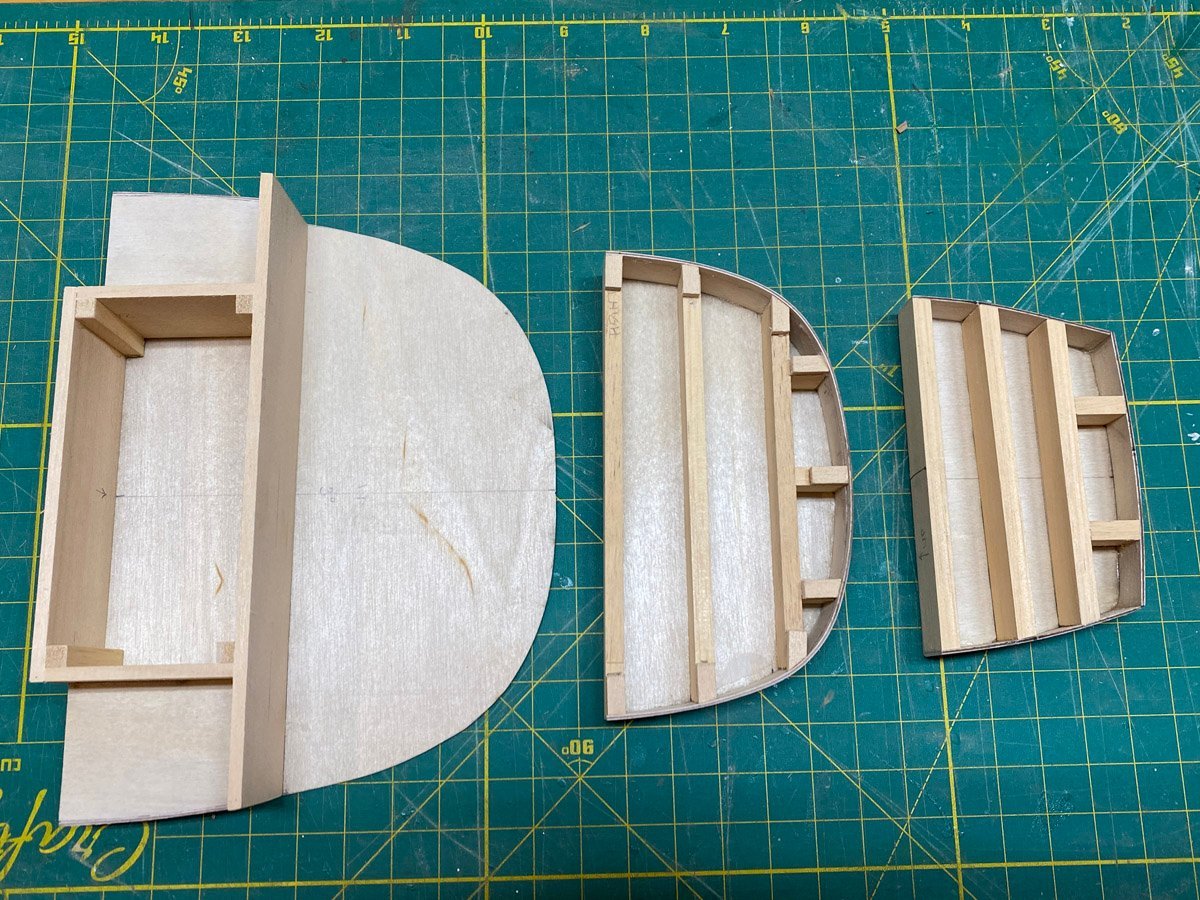
Cabins A, C after repairs, and B.
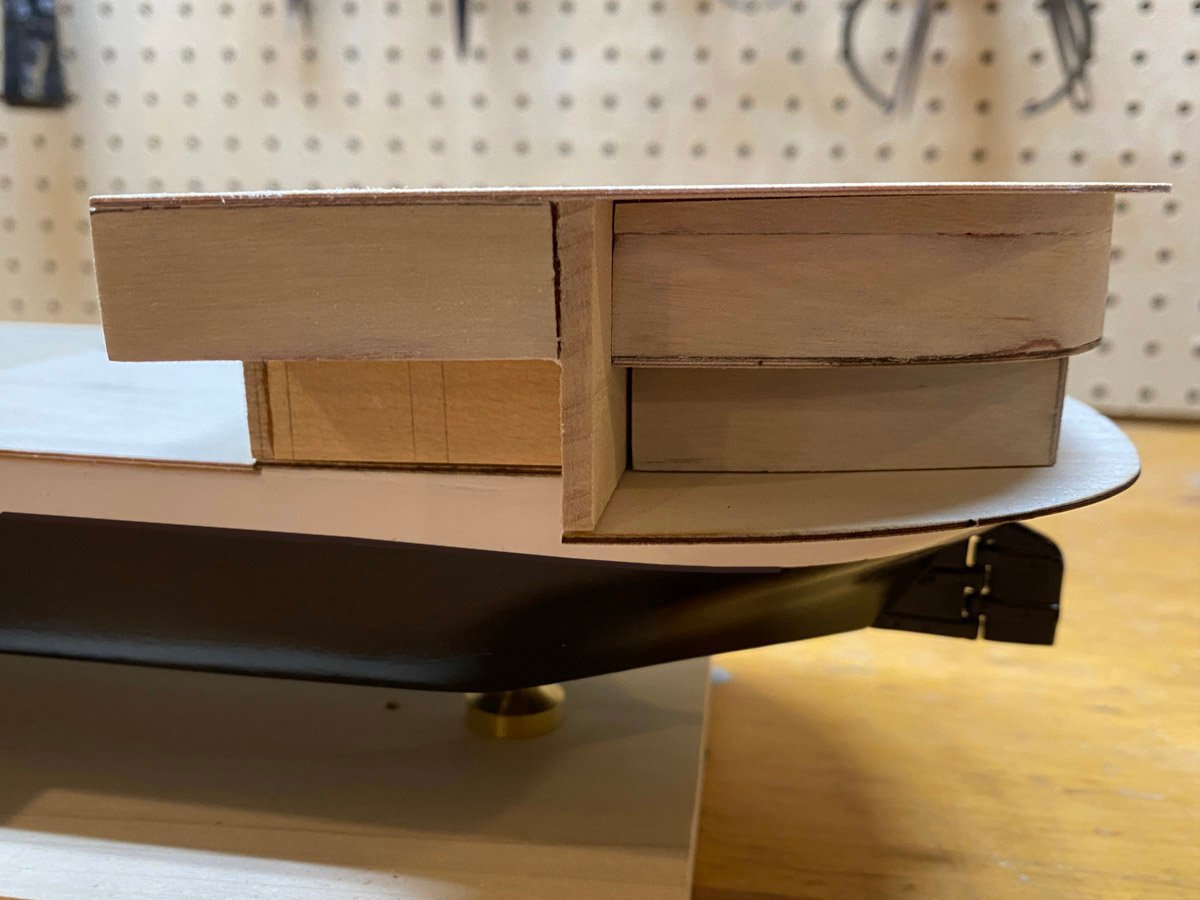
Now everything stacks up correctly. This will all get covered with doors, windows, and planks eventually.
- gsdpic, GrandpaPhil, Canute and 1 other
-
 4
4
-
Deck Construction
I finished painting the hull and attached it to a temporary stand. I ordered a nice cherry stand and brass pedestals from Bluejacket Shipcrafters but will have to stain and finish it first.
Four thin plywood deck segments get glued to the hull with huge overhang all around. The ship is like a barge with a gymnasium built on top.
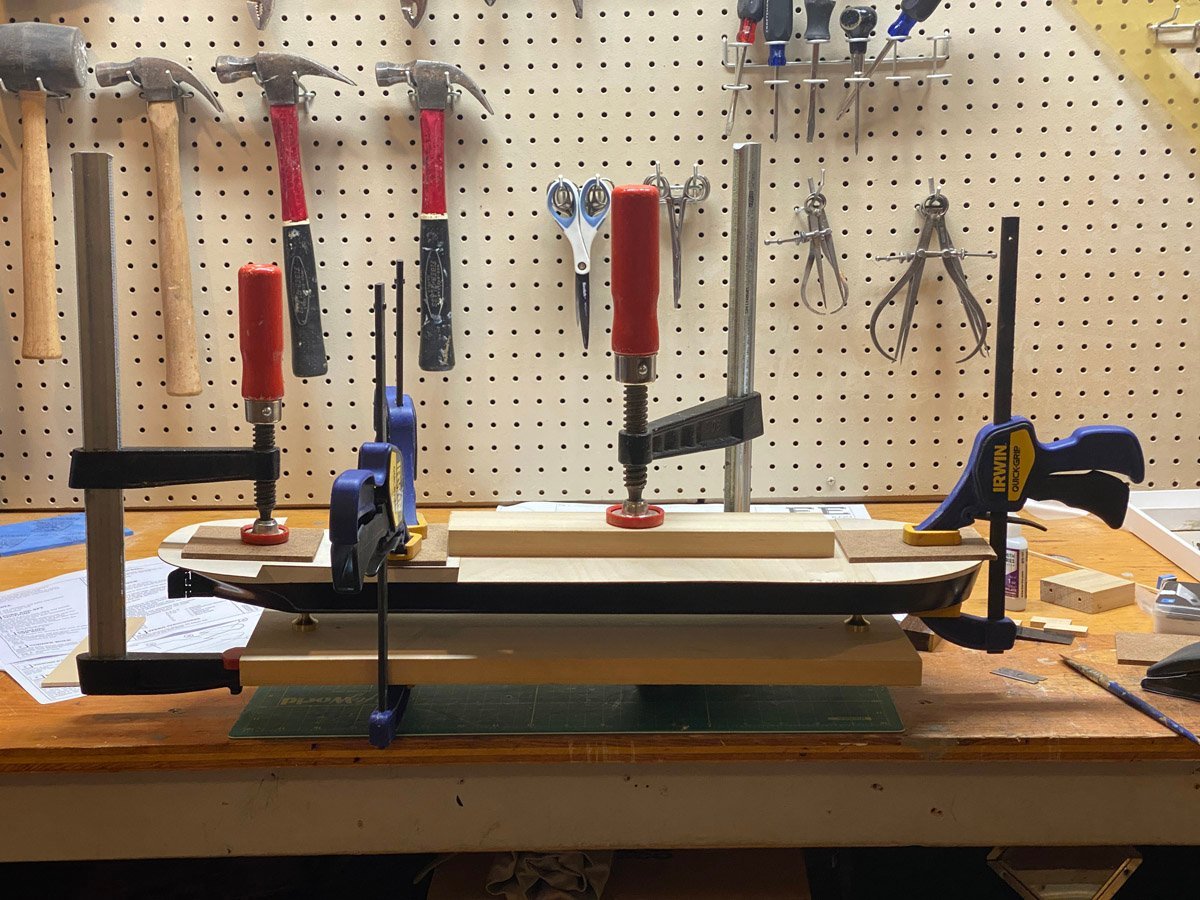
Decks glued and clamped. This is probably one of the few times that I'll use Titebond glue.
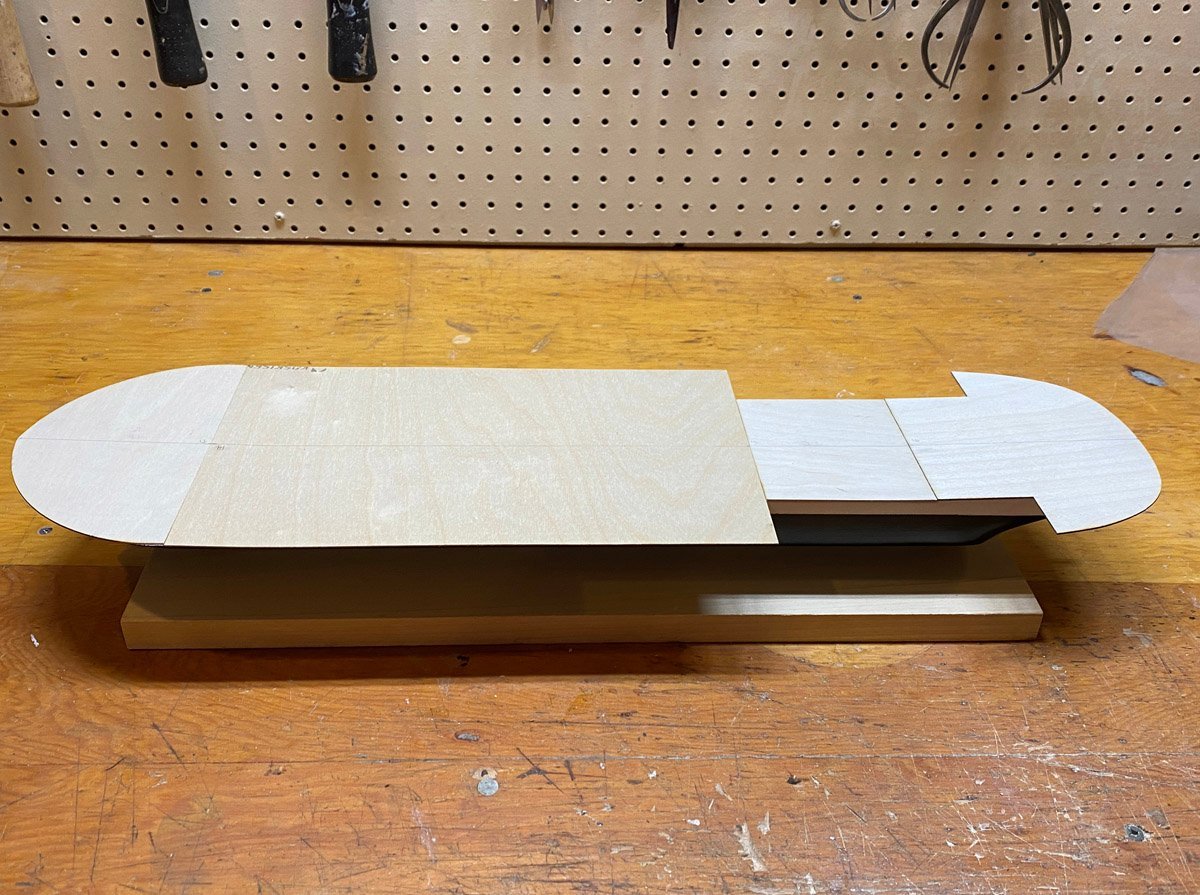
Decks glued in place. No one will ever see the hull.
- schooner, GrandpaPhil and Canute
-
 3
3
-
- kgstakes, Rik Thistle, Nunnehi (Don) and 4 others
-
 5
5
-
 2
2



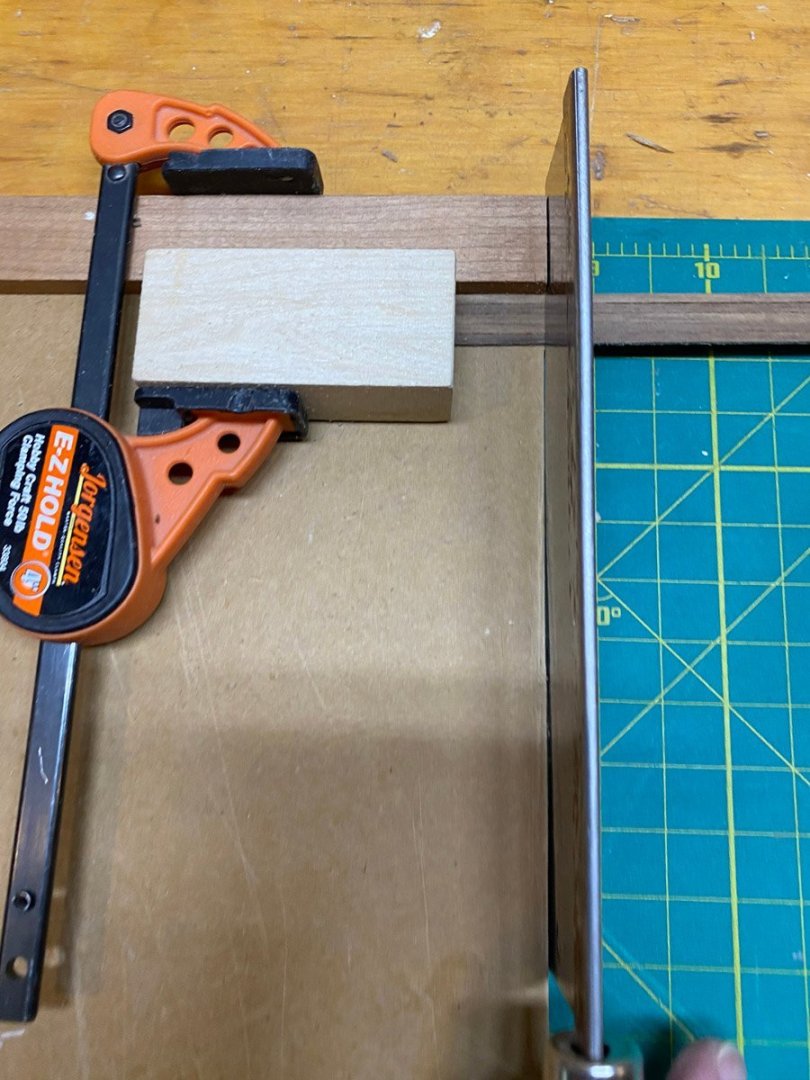
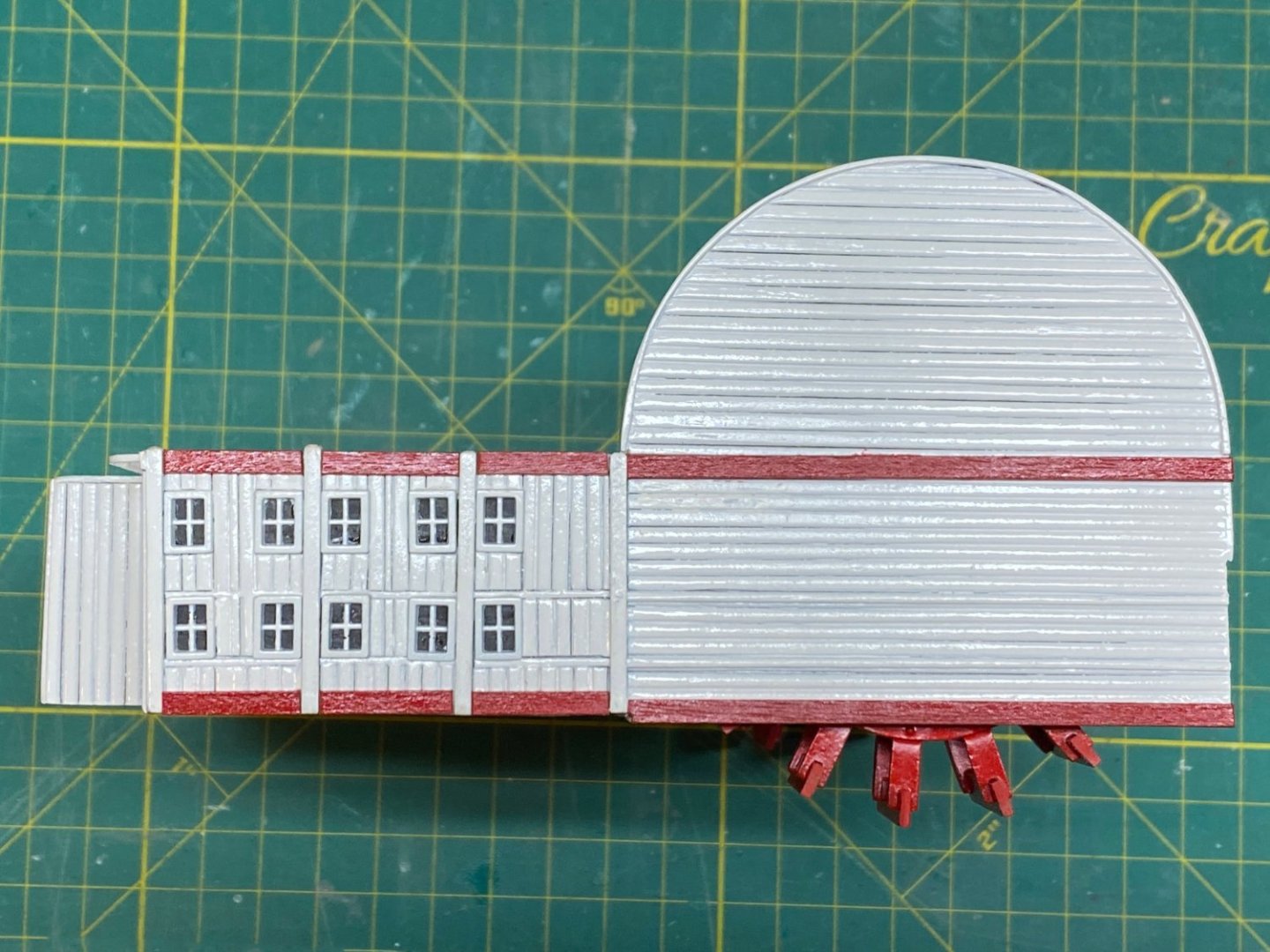
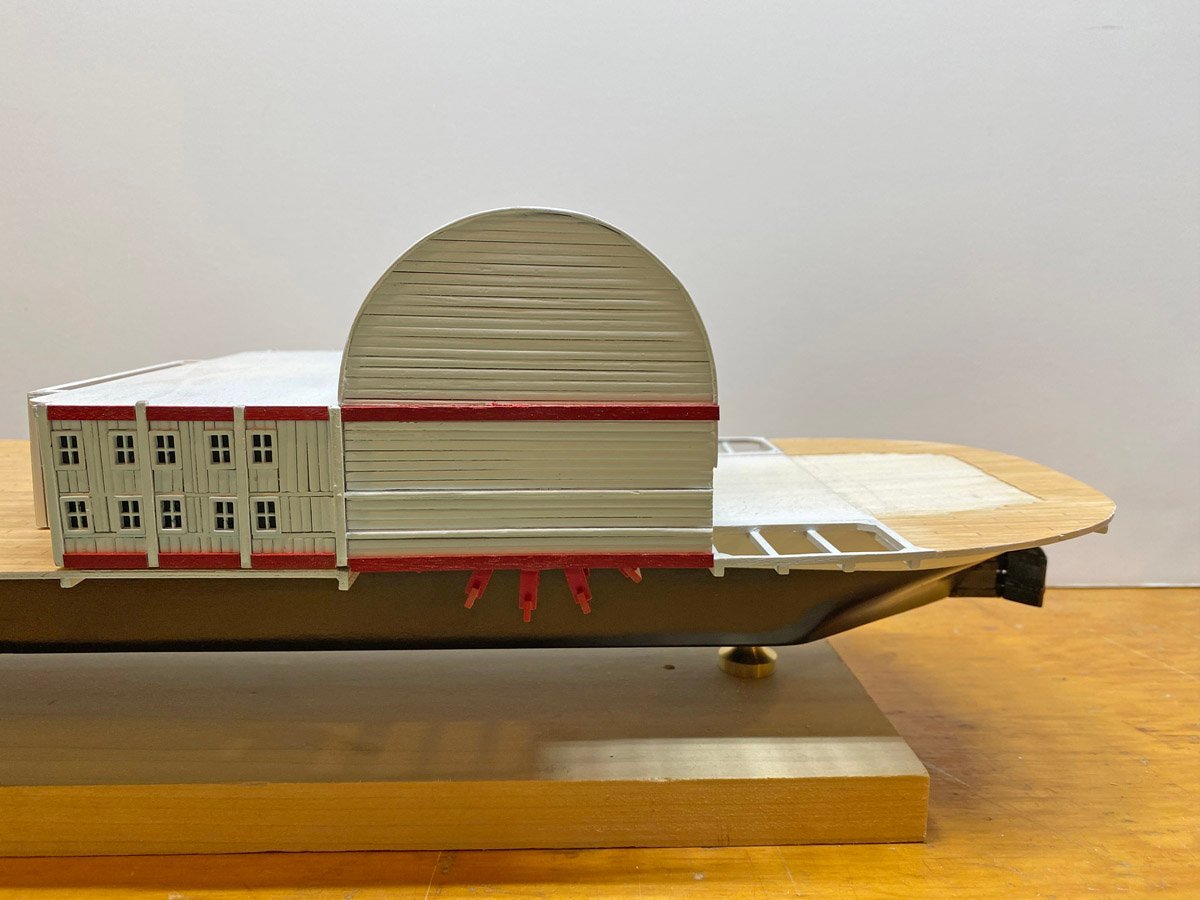
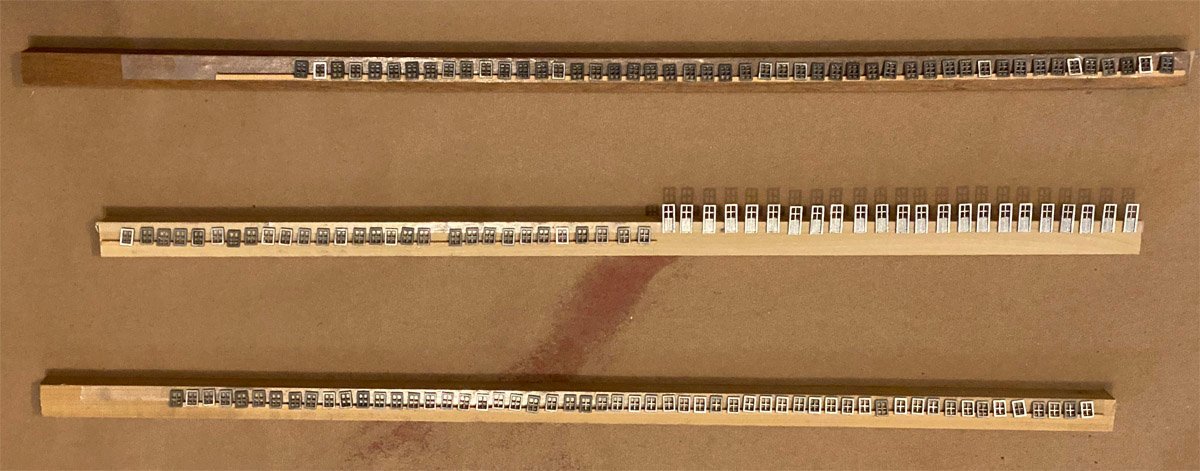

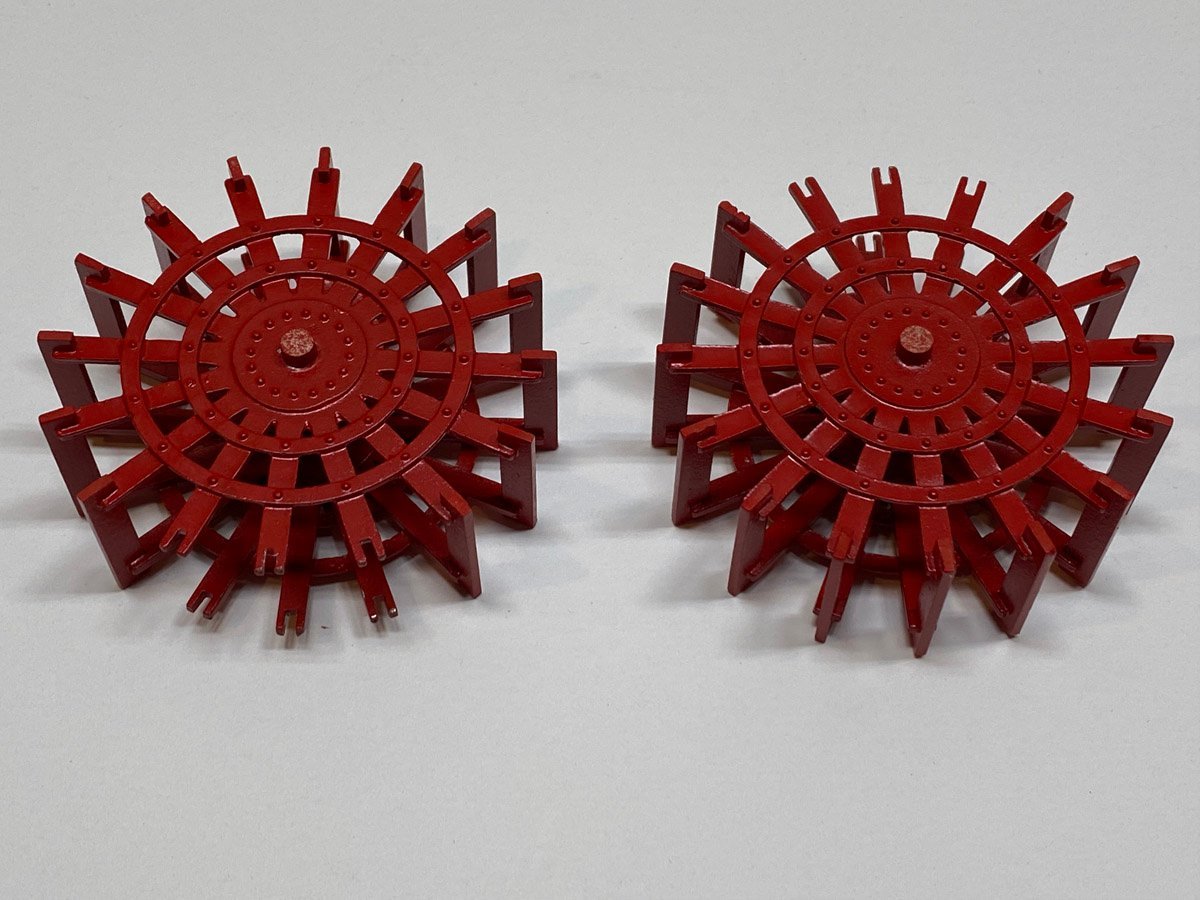
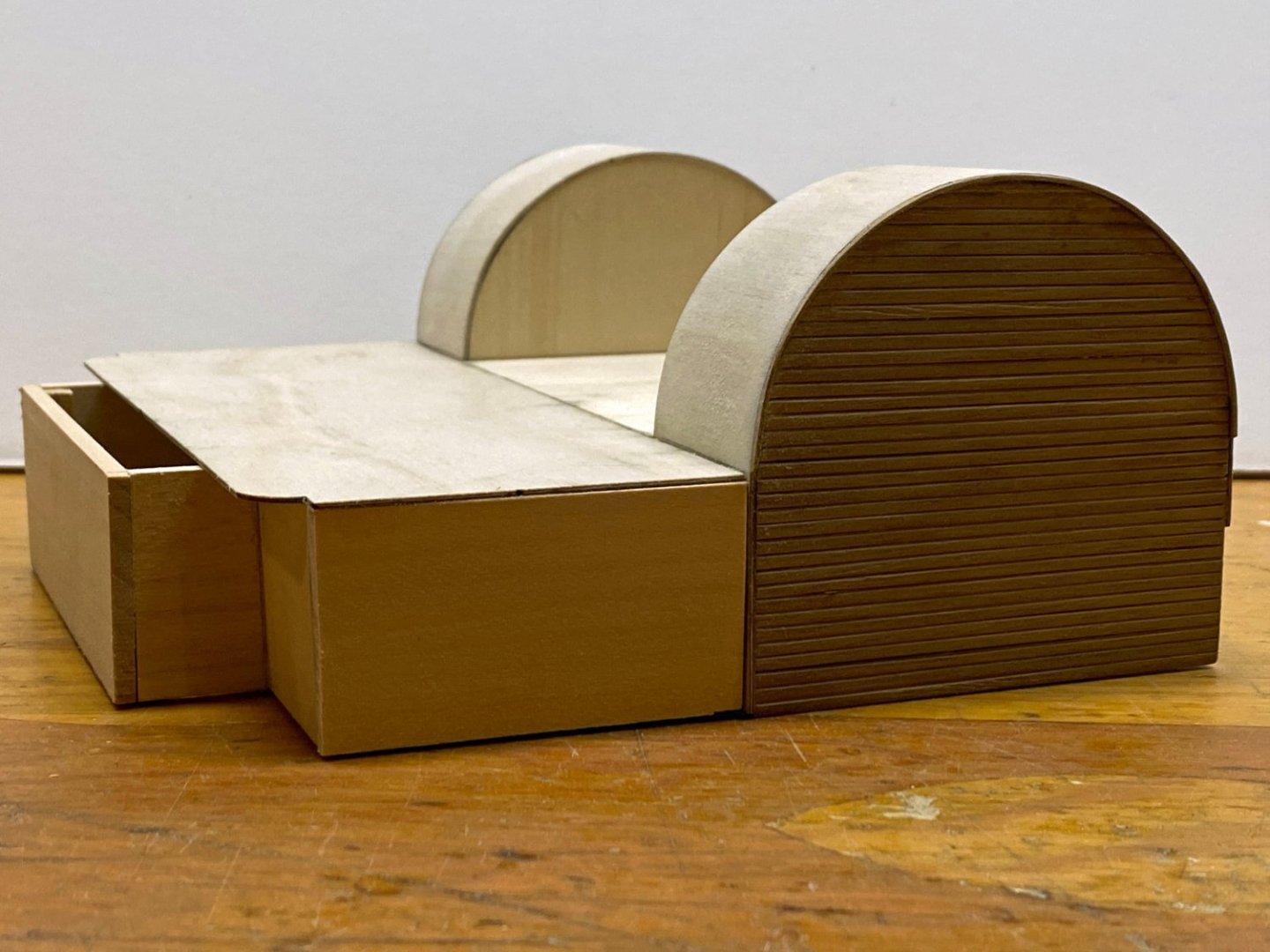
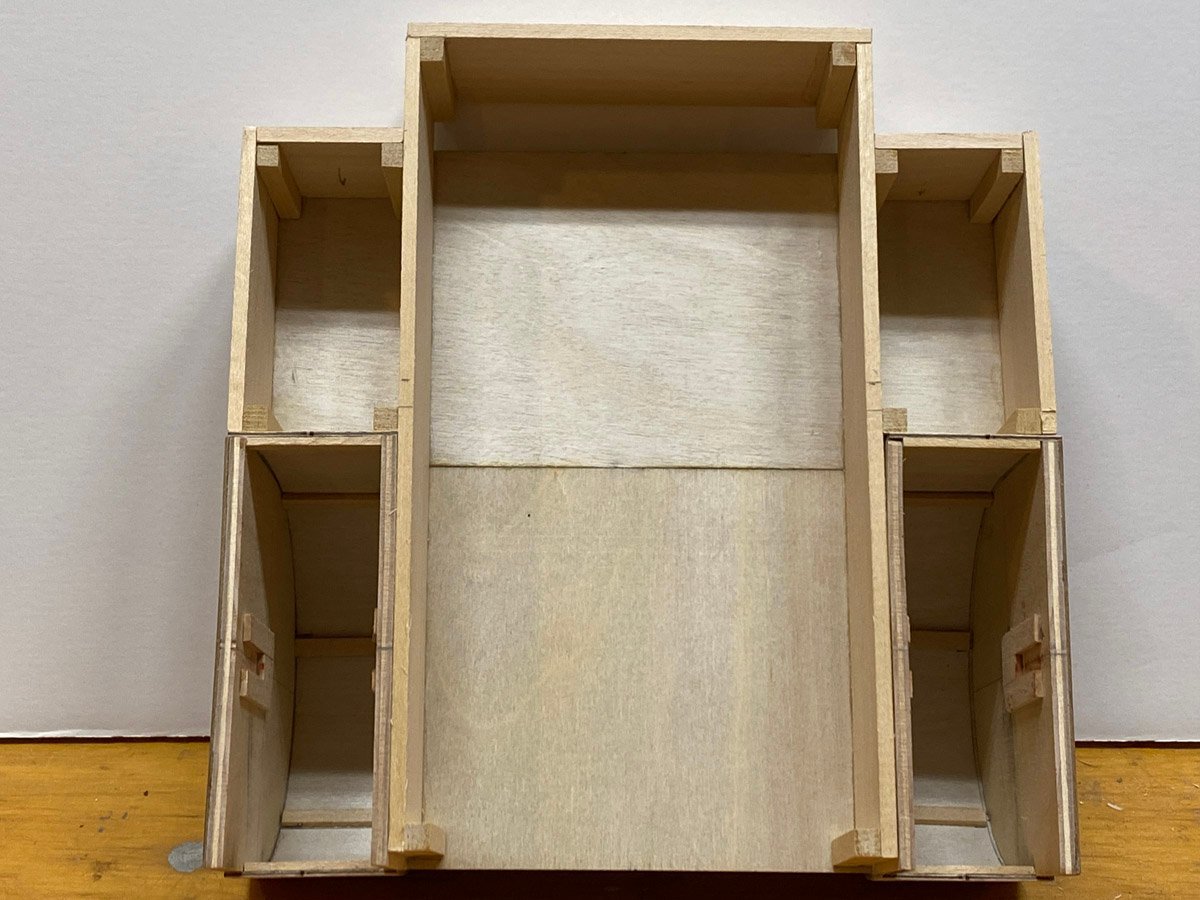
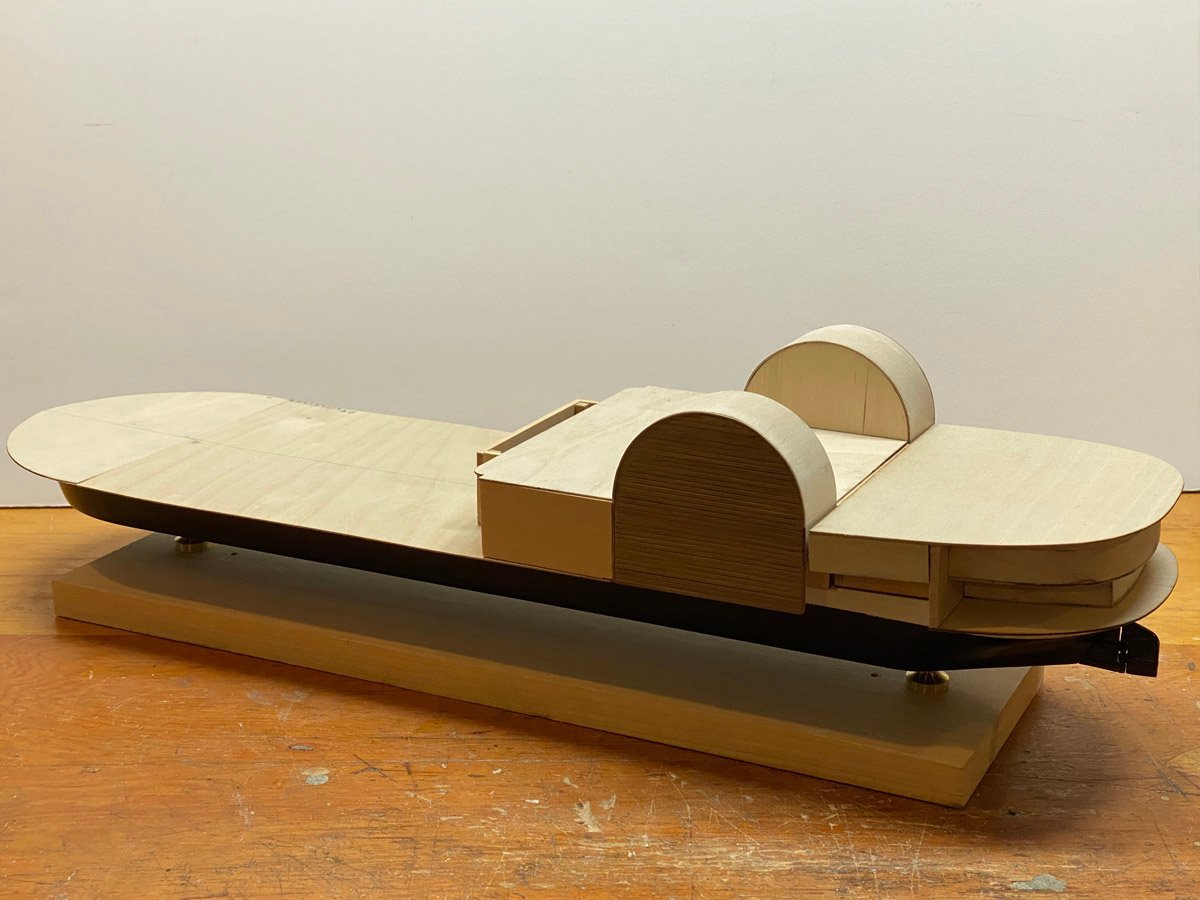
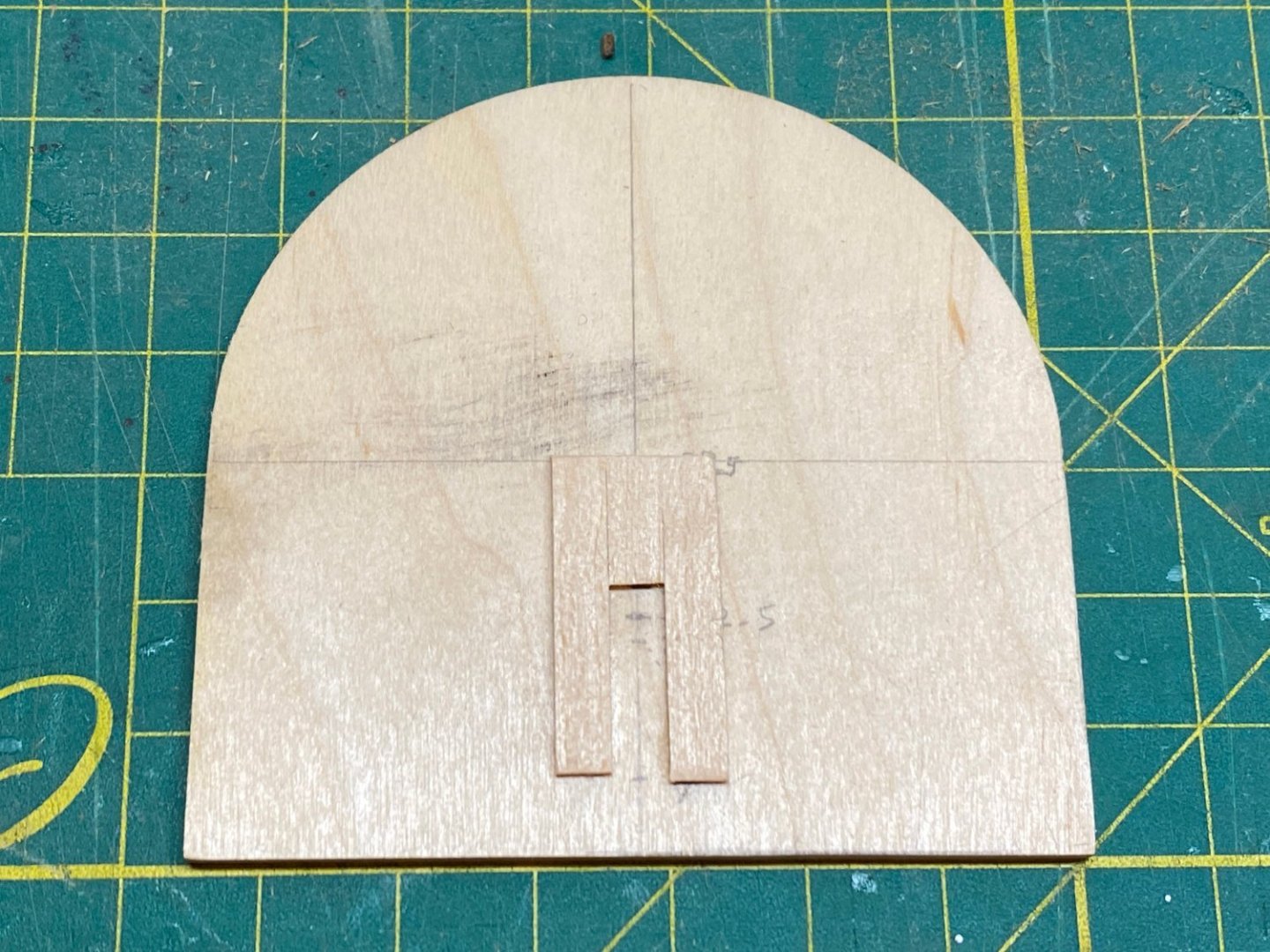
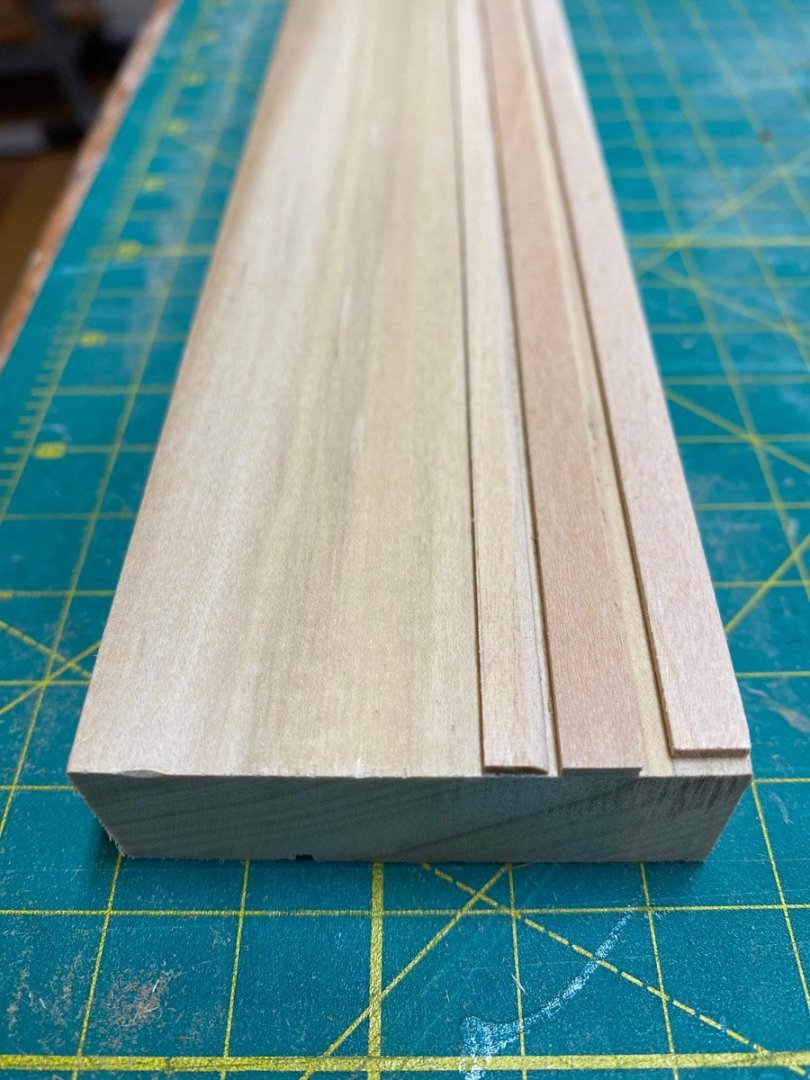
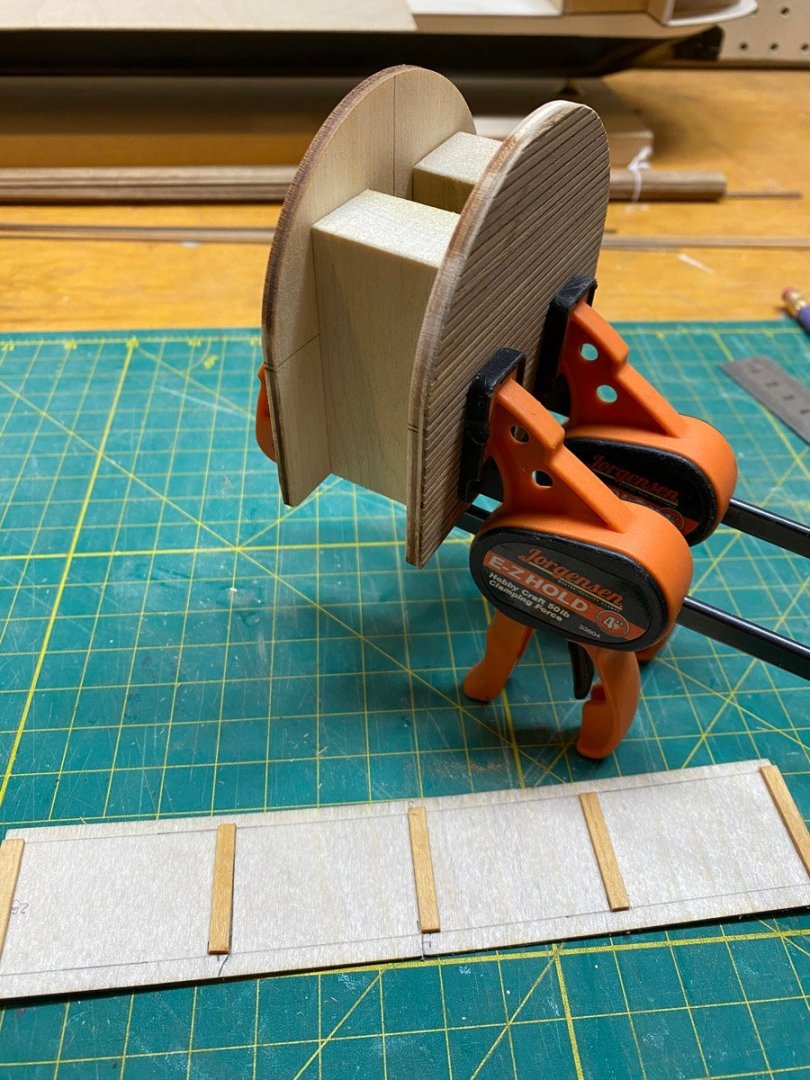
Sanson by hof00 - FINISHED - Artesania Latina - 1/50 - 19th century tug
in - Kit build logs for subjects built from 1851 - 1900
Posted
Congratulations Harry, she looks great! I like the lights too.